 |
From Bhutan to Bombay
part 2 - from Hyderabad to Bijapur, Hampi, Goa and Bombay
November-December 2006
|
Our whole route from Bhutan to Sikkim, Darjeeeling, Calcutta, Bhubaneswar, Hyderabad, Bijapur, Hampi, Goa and Bombay. |
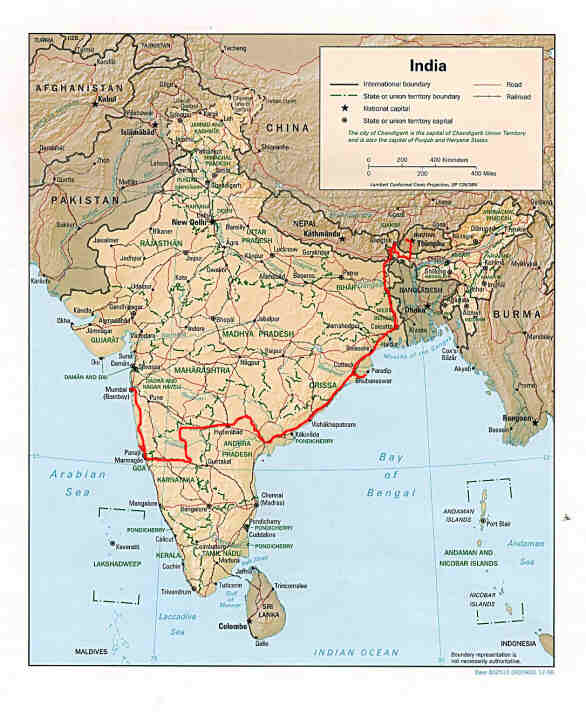
|
To see part 1, the beginning of our journey from Bhutan to Darjeeling, Calcutta and Bhubaneswar, just click on Ganesh.
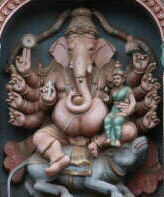
|
Hyderabad, Andhra Pradesh state (now Telangana since 2014)
|
Sat 25th November. After a bit of a rushed start, because of the slow service at breakfast, we caught the 8:25 Visakha Express for the 23-hour, 700 mile journey from Bhubaneswar to Hyderabad. It was very pleasant sitting watching the patchwork of paddy fields go past the window. The hotel had just managed to produce the packed lunch we ordered as we were scrambling into the taxi, so we sat in the train having a picnic of tasty chicken tikka and onion bhajis and buying cups of sweet tea from the chai-wallah as he went up and down the corridor. When it went dark we got into our bunks (in 2A class - two-tier, air conditioned with bedding but no separate compartments) and had 12 hours of rather uncomfortable but quite pleasant dozing to the clickety clack of the train and waking up at the frequent stops. Nevertheless, suddenly it had got light and we arrived at Secunderabad, the main train junction for Hyderabad.
Sun 26th. As we walked out of the station we ignored all the taxi touts and walked through the motor stand and out onto the main road where there was a row of autorickshaws, and found a very nice driver who agreed to take us wherever we wanted on the meter, so we didn't have the hassle of negotiating. It was just as well, because all did not go smoothly - first, half the main roads in town were closed for a half marathon run today, then the hotel we wanted to stay in was full. The driver took us to a succession of hotels, or rather doss houses that were truly awful, and we were just beginning to despair when we happened to drive past the hotel Suhail down a side street, which looked alright and turned out to be quite acceptable for four pounds, half the inflated prices of the doss-houses. Even so, like all the other hotels, they had a 24-hour checkout policy and it was still before 8am, so we agreed to leave the luggage with them and go and have breakfast, then check in later. Having got such a good deal on the hotel we decided to splash out on breakfast, and took our autorickshaw driver for a final drive across town to the Viceroy Hotel by the lake. This included going through a police road block and down one of the closed streets - apparently a couple of white folk hanging out of the back of the rickshaw calling out 'Viceroy hotel' swung it with the policemen. The Viceroy turned out to be a Marriott hotel and we had a wonderful, totally westernized buffet breakfast with smoked salmon, salami, cheese, etc., which cost us £14, three times the price of our hotel room but worth every penny!
After checking into the hotel at last we got another autorickshaw out to Golconda Fort on the outskirts of Hyderabad and found it an impressive and fascinating place. A huge palace and fort complex built on a granite hill, it was the centre of a great empire in the 16th century. It seems to be a popular place for local people on a Sunday day out, and lots of them asked us to be on their photos (we seemed to be the only westerners there, which is surprising because this should be a great tourist attraction). |
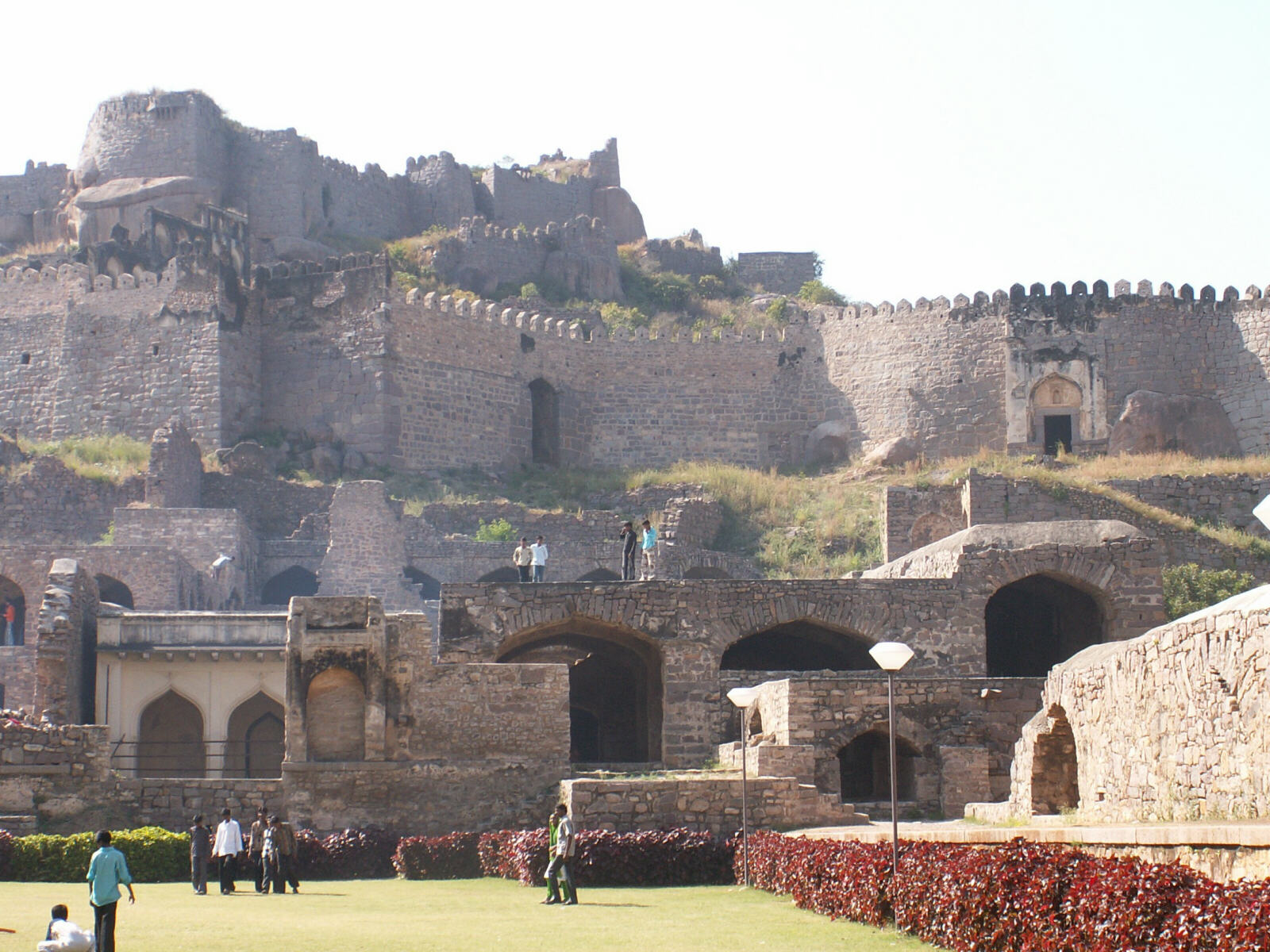
|
There didn't seem to be any restaurants in the Abids area of town where we are staying so we picked the Hunters Roost in Secunderabad out of the book and tried to go there. It was not so easy because the autorickshaw drivers seem to like to stick to their local area and when one did volunteer to take us we got hopelessly lost and had to keep asking for directions. However, it was worth it because the Hunters Roost was a very pleasant semi-open air restaurant and we had a really tasty meal.
Mon 27th. We left our bags in the hotel luggage office and went to see the Charminar, the symbol of Hyderabad, a wonderful arched structure with four minarets, situated at a crossroads in the bazaar quarter of town. It was fascinating standing on the first-floor balcony watching all the activity in the streets below, with countless barrow-boys selling spices, fruit and veg and all sorts of kitchen implements as their potential customers flowed around them, mostly black-clad Muslim women and a smattering of others in brightly-coloured saris. Around them swirled the endless chaos of autorickshaws and motorbicycles, mostly carrying whole families recklessly through the turmoil. |
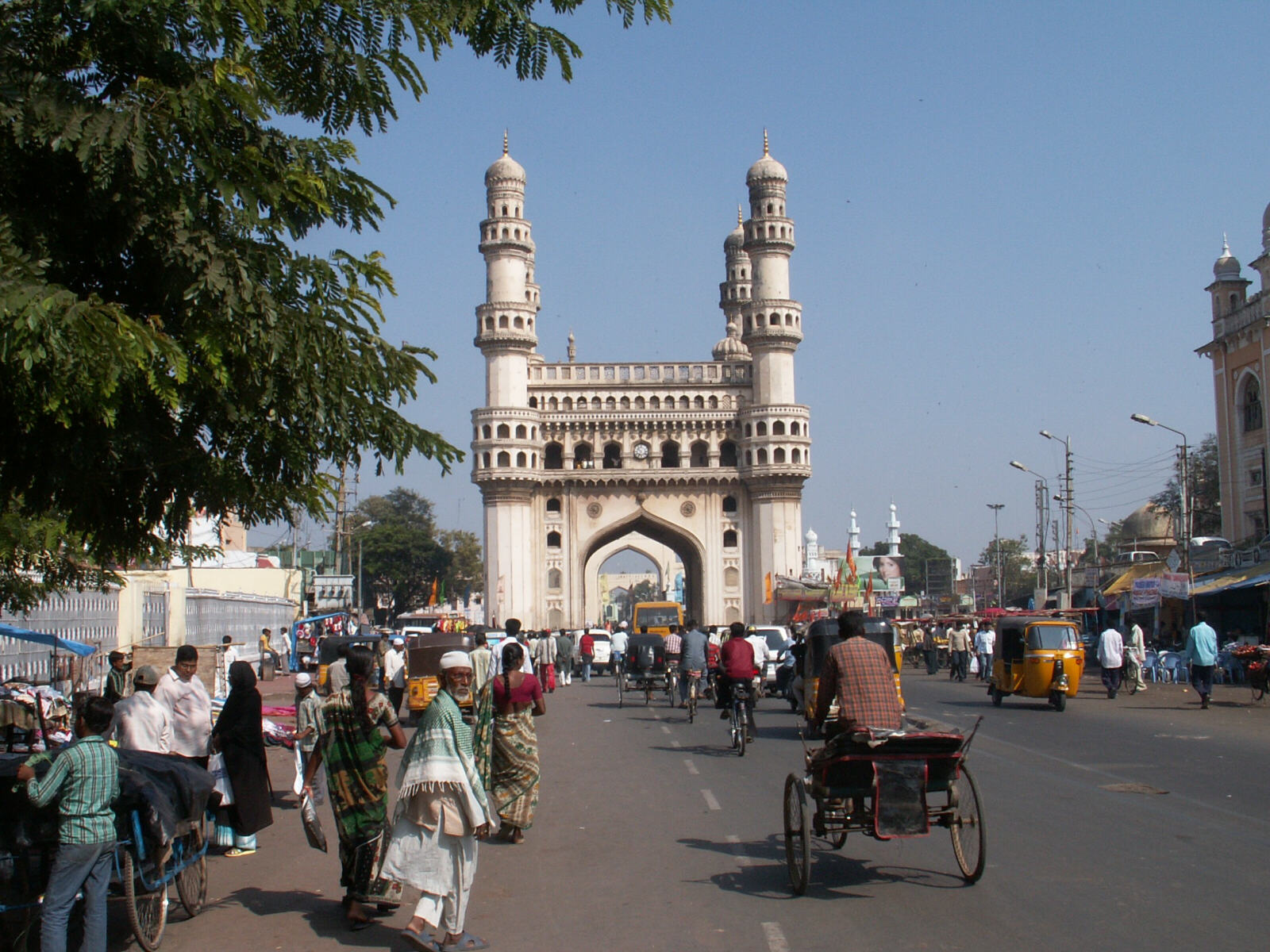
|
In the bazaar area around the Charminar the samosas are selling well .... |
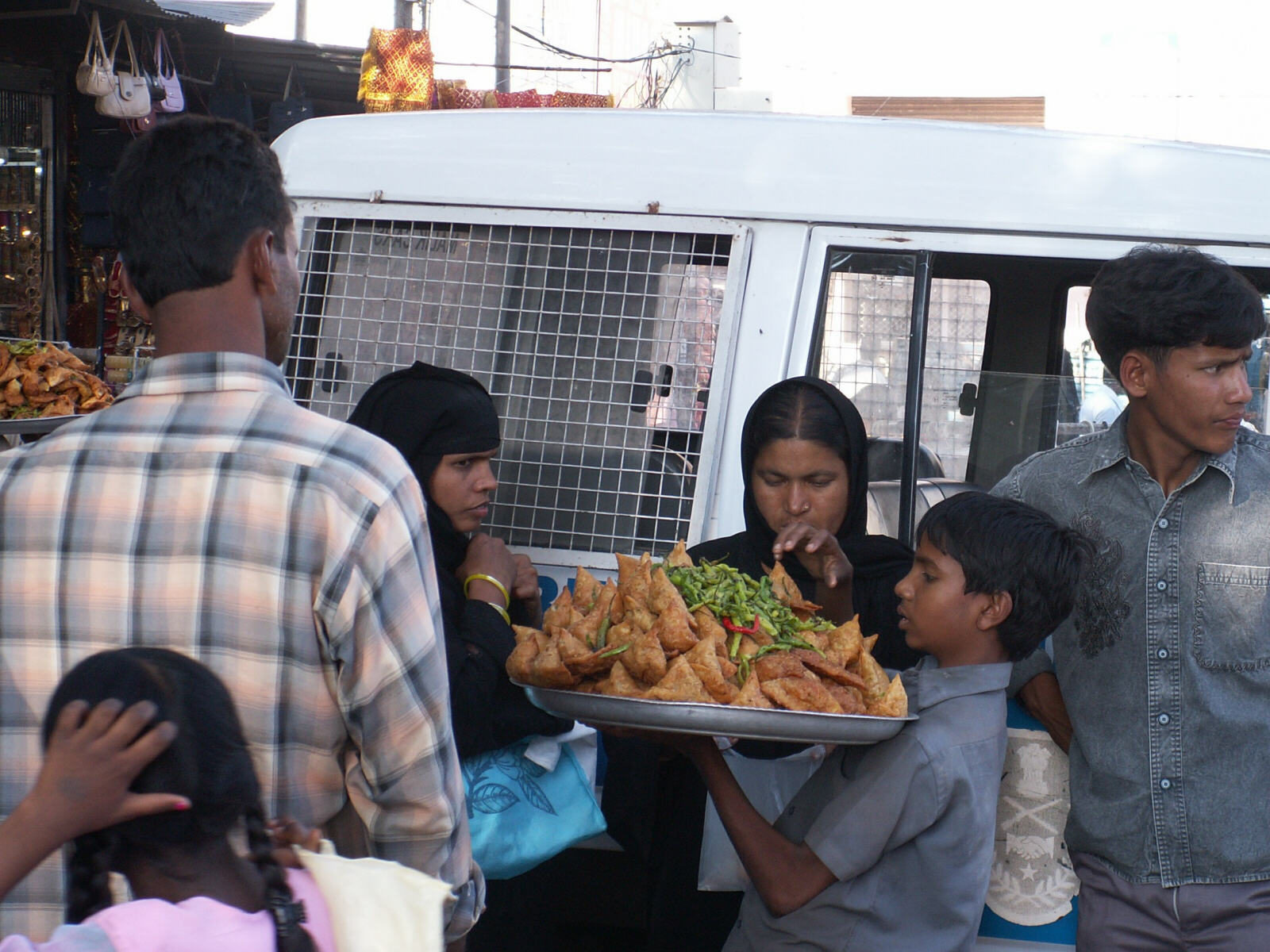
|
.... wherever you look .... |
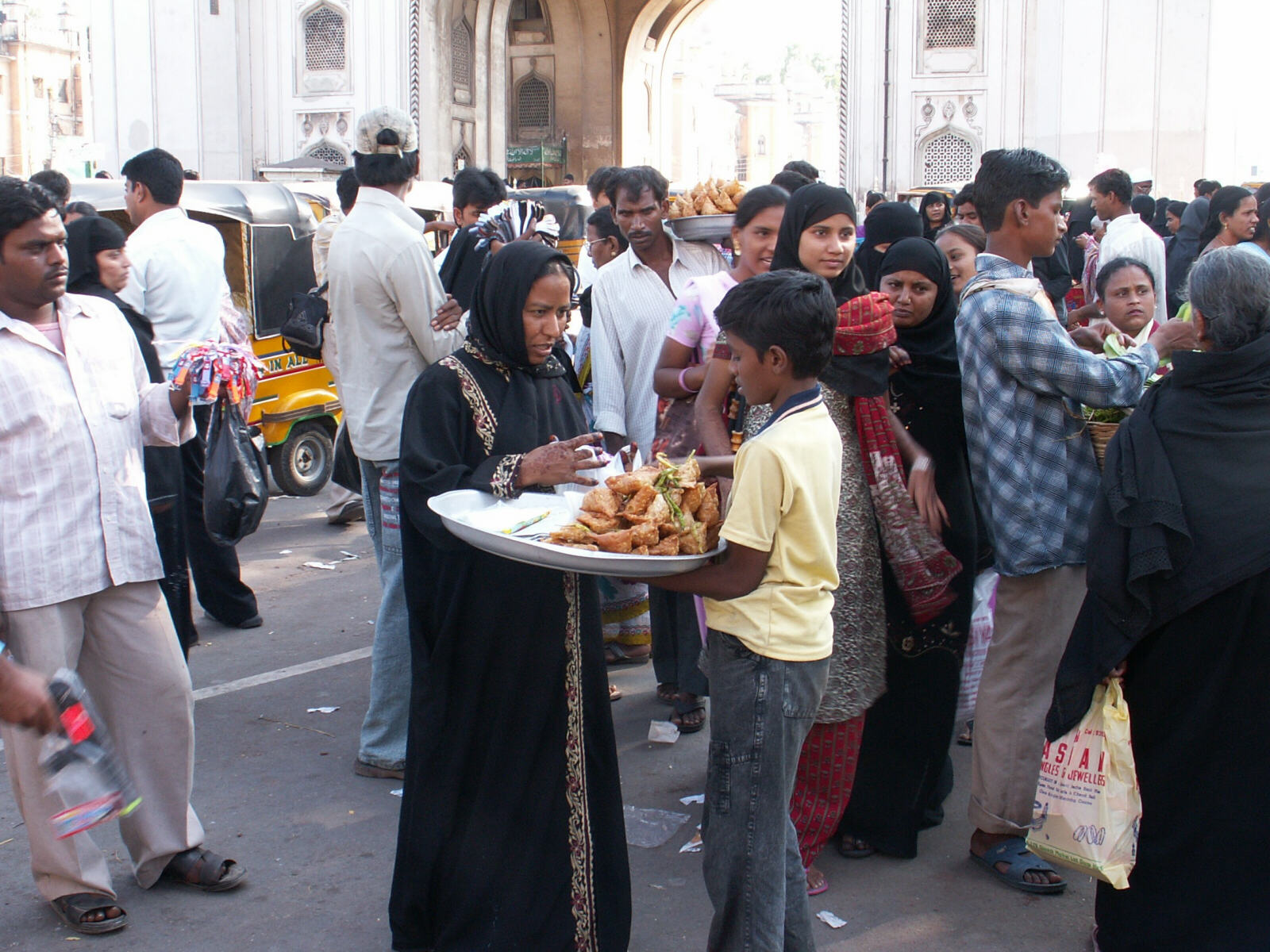
|
.... and more are on the way.
|
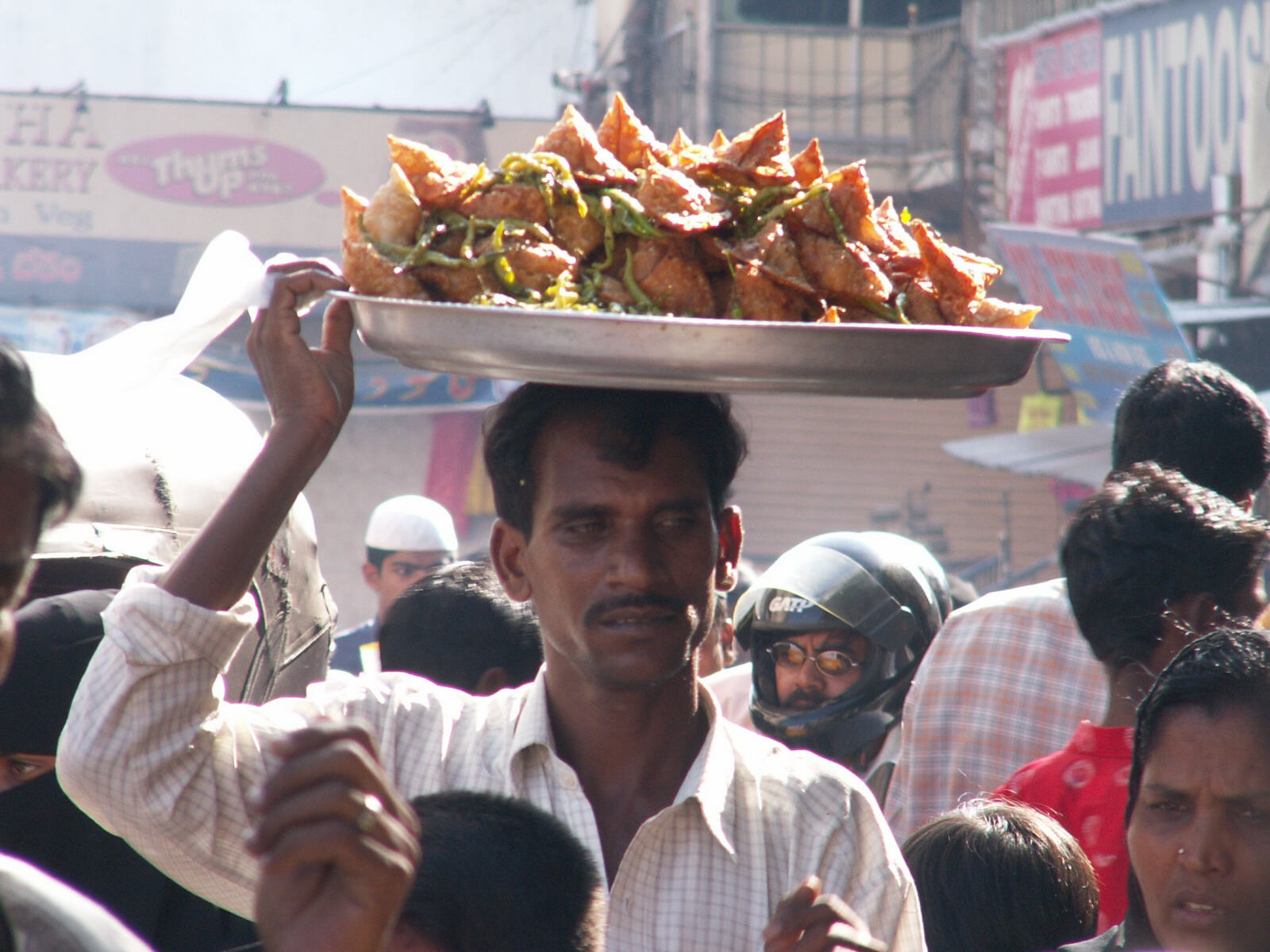
|
We wandered round the bazaars soaking up the atmosphere and also went into the nearby Mecca Mosque which was huge but very plain ... could this be a secret hidden door into the mosque? |
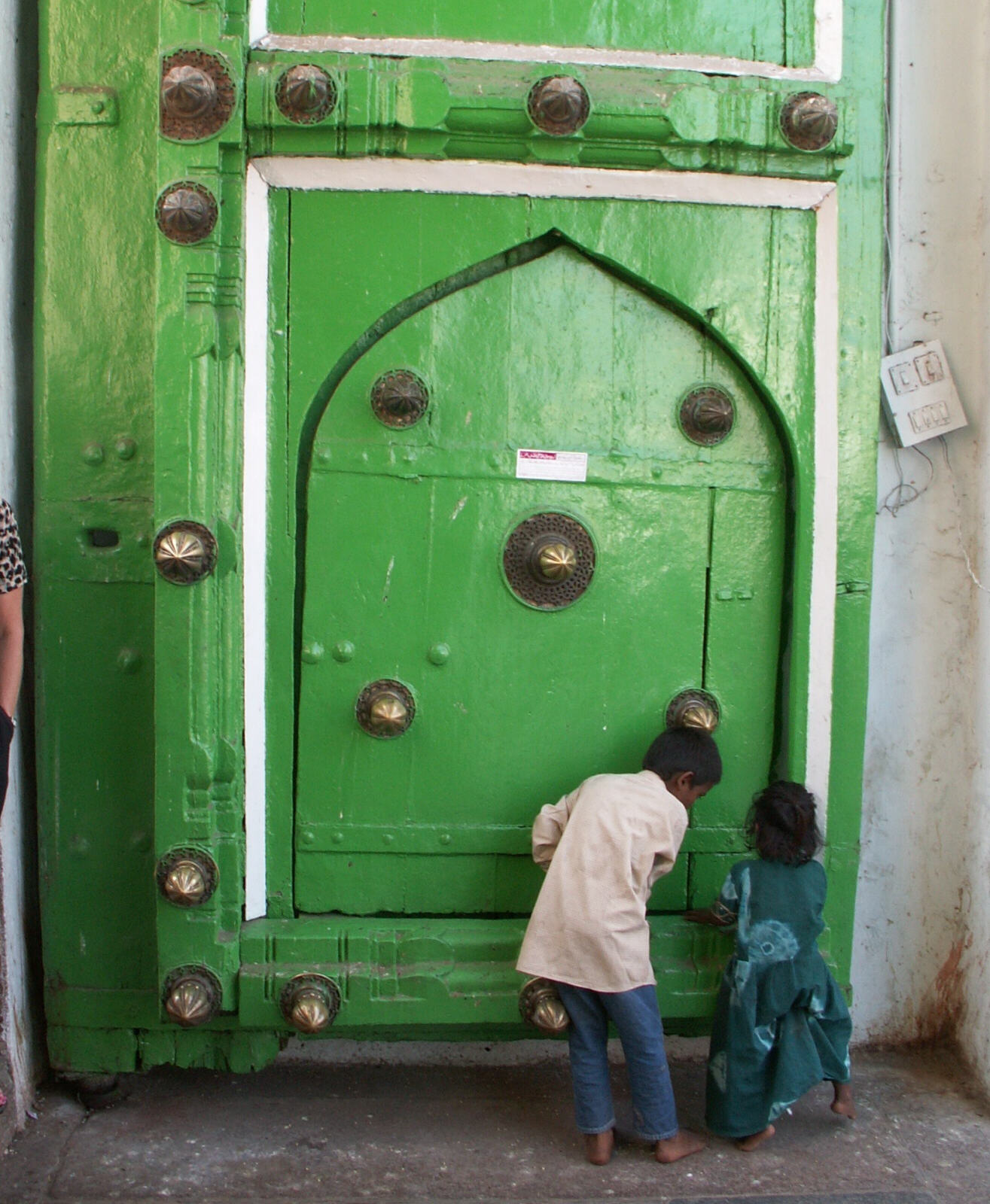
|
By about 4pm we had had nothing to eat or drink except sweet Indian tea in a little restaurant, so we went to the other end of town to return to the Hunters Roost for another great Indian meal. We lingered over it so long and then the traffic was so bad, that we ended up in a big rush to catch our 19:50 train from Hyderabad station. The train on the line to Bijapur only has 'sleeper class' accommodation but we didn't really know what that meant so we walked the length of the train looking for a compartment that wasn't packed with people sitting on wooden benches, but we couldn't find anything that looked like a sleeper. Eventually we saw a passenger list attached to the first carriage we had walked past and found with dismay that our names were on it. We had got two top bunks in a crowded three-tier, non-AC cabin, with no bedding supplied. We had brought a couple of blankets and a blow-up pillow so we actually had quite a comfortable night, apart from the snoring all around us and the smell of the toilets occasionally wafting down the corridor. This was probably our least-successful train ride. |
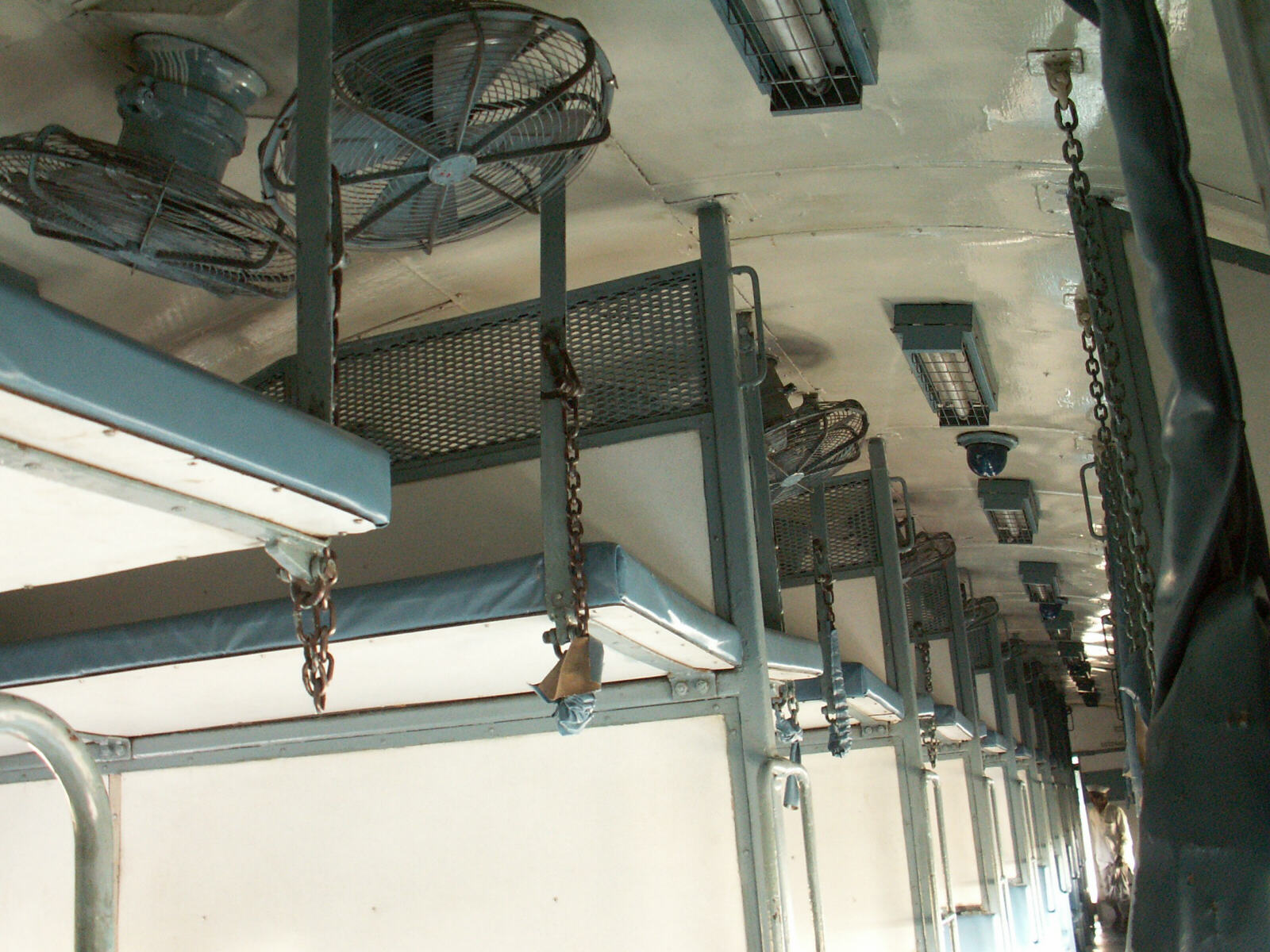
|
Bijapur, Karnataka state
|
Tues 28th. The last few hours of the journey were through more of the green Indian countryside and we arrived in Bijapur at 10am. Bijapur town is fairly run down so the idea was to see a couple of the key sights and then move on, but in fact a horse and carriage man 'captured' us at the station and we agreed to go on the full 10-point tour of the town with him. First we went to the bus station where there is no official 'left luggage' office but the booking office people very kindly let us leave our bags with them. Then we went back to the main reason for visiting Bijapur, the immense Golgumbaz, which is the mausoleum of a 17th century king and has the third-largest dome in the world (first is St Peter's in Rome and second is an African dictator's wild extravagance in Cote D'Ivoire). It was certainly impressive for size although not particularly pretty, and there is a 'whispering gallery' high up under the dome but the Indian kids don't quite get the concept of whispering and the place was a cacophony of yells, screams, whistles and claps reverberating round and round. |
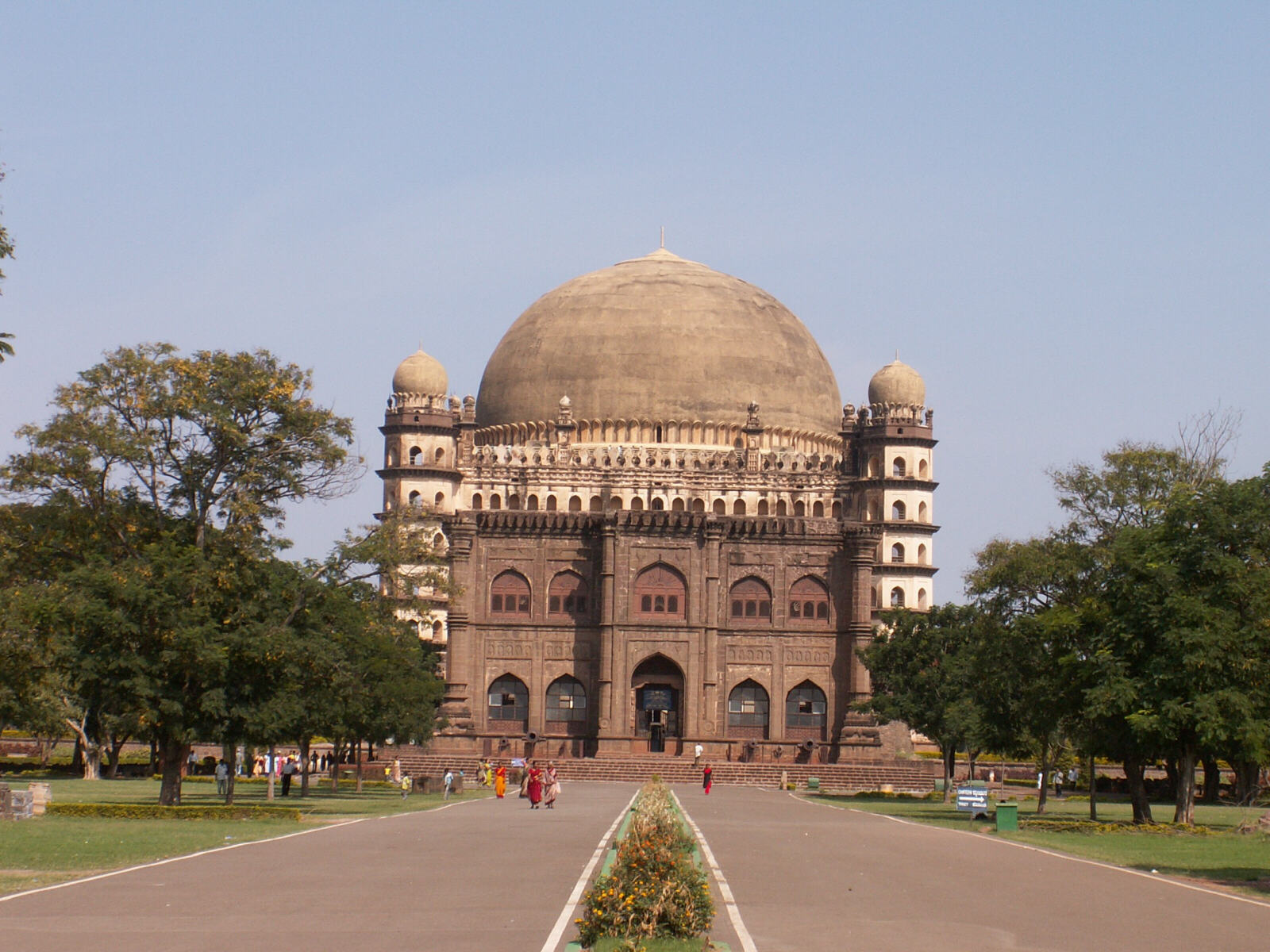
|
Next we went to the large Jama mosque and then the Mihtar Mahal, a much smaller but beautiful mosque with a very elaborate tower in one corner of the compound. We then passed through the fortifications of the former citadel and paused to take photos of the ruined palaces. |
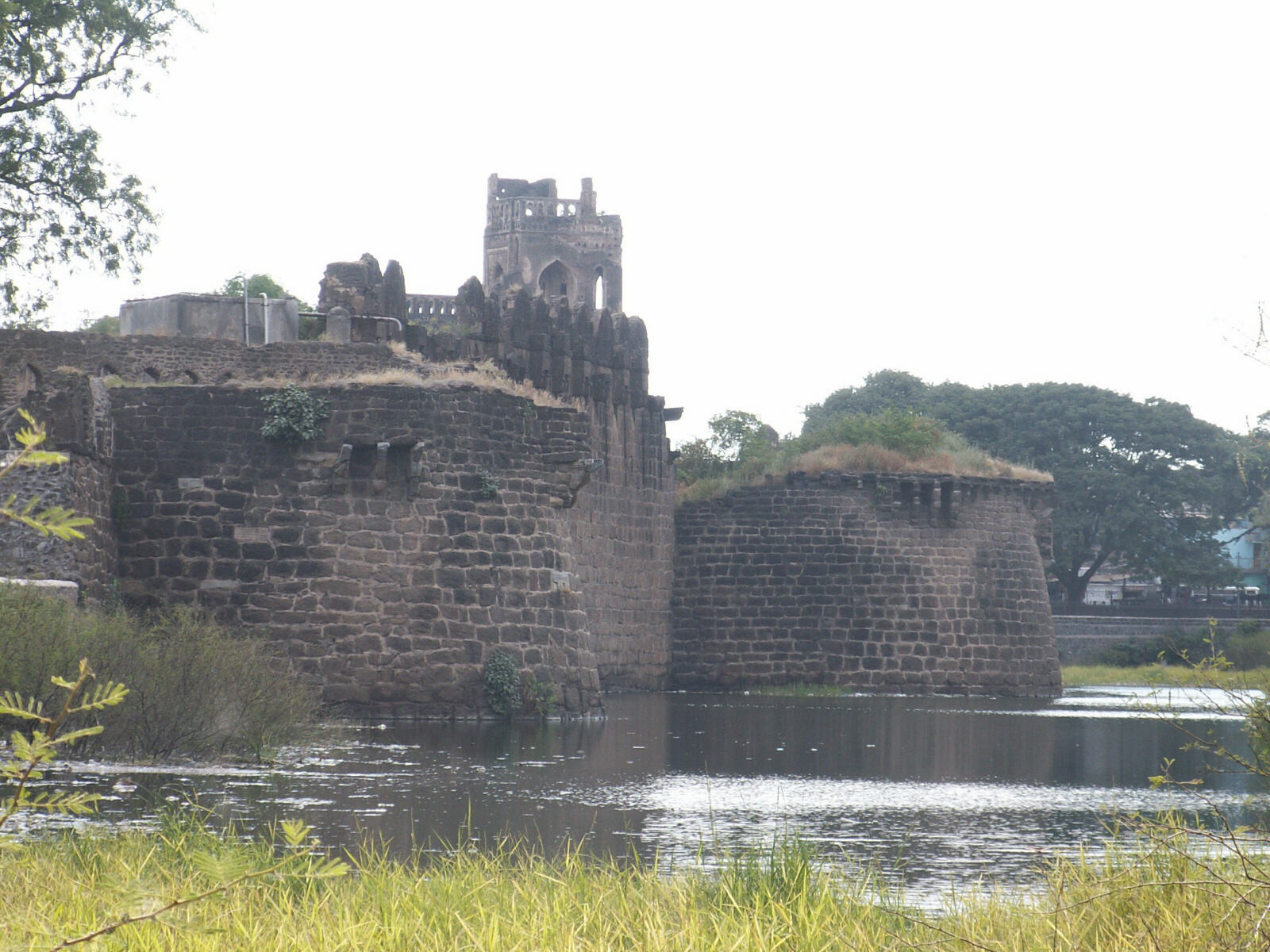
|
Then on to the nearby Bara Kaman, which is the ruined mausoleum of another of the former kings. This was impressive for the forest of pillars and arches which must once have supported a huge roof. After stopping at a horse trough for the horse to have some refreshment we plodded on to the other side of town where there was a sturdy 11th century stone watchtower with good views of the town from the top, and not far away on a bastion in the old city wall was a huge cannon cast in 1549, with a radius of almost 1½ meters and weighing 55 tons. Outside the western city wall was the other 'main event' in Bijapur, the Ibrahim Roza mausoleum. These beautiful twin buildings are set inside nicely kept gardens and as well as being impressive are also highly decorated with stone filigree unlike the rather plain but immense Golgumbaz.
|
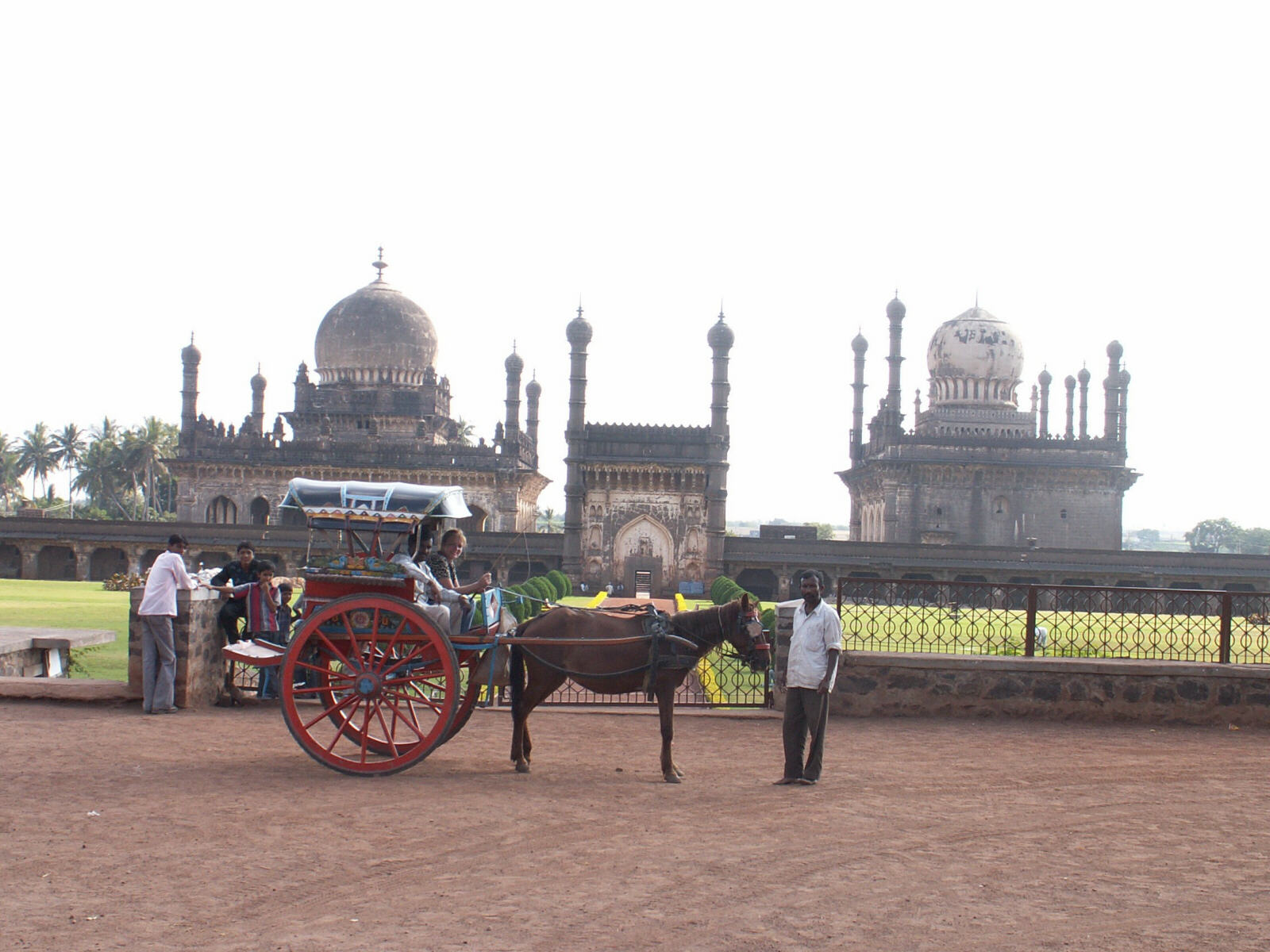
|
We clip-clopped back through the city wall and stopped at an historic but horribly polluted water tank (a 'tank' in India is typically the size of a football field) where a group of women were cheerfully washing their clothes in the awful water. By now we were hot, dusty and exhausted so we passed by the last stop on the tour, another mausoleum, and went back to the bus station. It was a really good tour, and a great way to do it in a horse-drawn carriage (well, a cart really), so we felt we had 'done' Bijapur very thoroughly, all in four hours! |
Hampi, Karnataka state
|
For once we phoned ahead to make sure we had somewhere to stay because we were arriving late and a lot of guest houses tend to close early, then we caught the 4 o'clock 'express' bus to Hospet, the transport hub near Hampi. The bus was actually the express to Bangalore and when it was on the open road it did indeed go quickly, but we kept turning off to stop in small villages along the way. Nevertheless we arrived in Hospet just after 9pm and immediately went to the New Eagle Garden restaurant which we chose from the book, to make sure we got something to eat before everything closed up (we hadn't had anything to eat all day). The garden restaurant was very nice, although rather dark and we had to use a torch to read the menu, and we had a very welcome meal and less welcome lukewarm beer. Then a couple of nice lads in an autorickshaw took us the 11 km to Hampi where the people at the Ranjana guest house had waited up for us and it was lovely, with a cool tiled floor and a big mosquito net on the bed, and all spotlessly clean.
Wed 29th. There were three upstairs rooms at the Ranjana guest house, arranged around a first-floor patio where we had breakfast in the morning sun, with views of temples, rock-covered hills and monkeys playing in the nearby trees. We were situated in the small 'travellers' area of Hampi bazaar with useful things like internet cafés, bus booking offices and countless restaurants nearby.
Then we set off on a mega-tour of the fabulous historic ancient ruins of Hampi. The area is full of the remains of temples and palace complexes from the Hindu kingdom of Vijayanagar which thrived here in the 15th century, and we spent five hours travelling round in an autorickshaw visiting two monolithic Ganesh statues, Hemakuta hill which is covered in shrines and temples, the Siva temple with its adjacent ancient colonnaded bazaar and a holy tank .... |
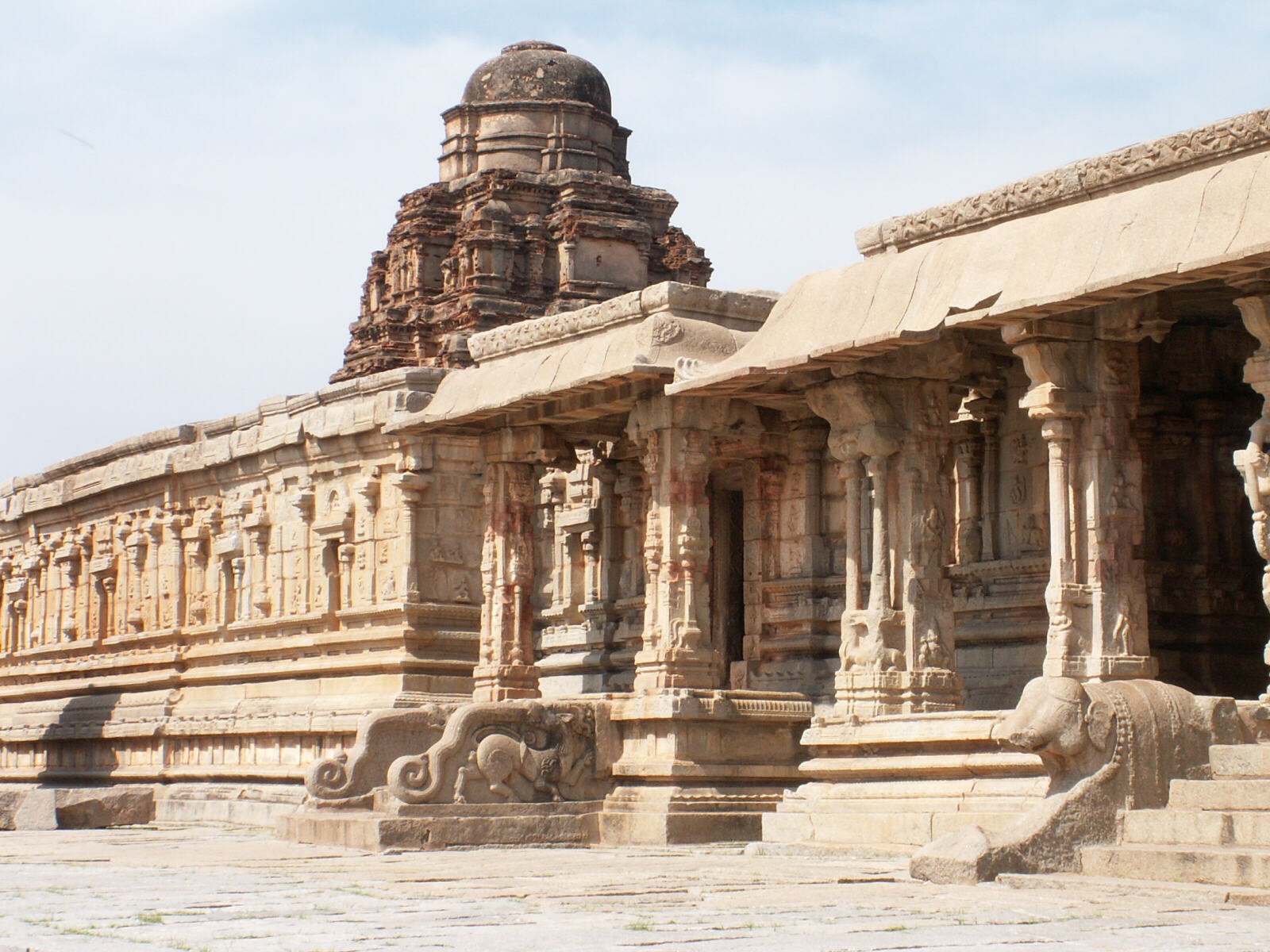
|
... and Lakshmi Narasima temple, all in the 'sacred centre' area. Then the 'underground' temple and the Zenana enclosure with great domed elephant houses with room for 11 elephants ....
|
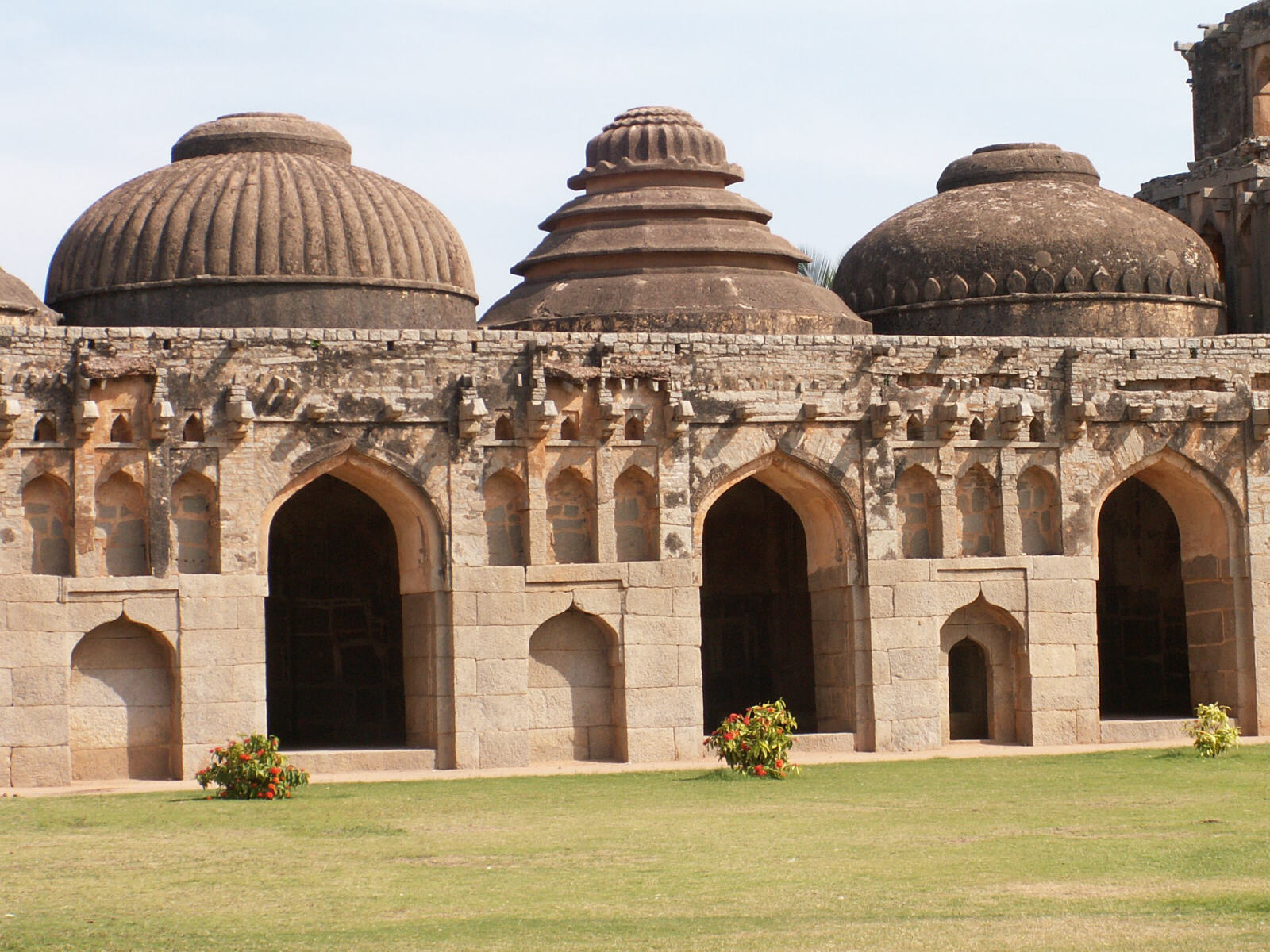
|
.... and a Lotus Palace with a well-behaved class of schoolchildren learning about its history.
|
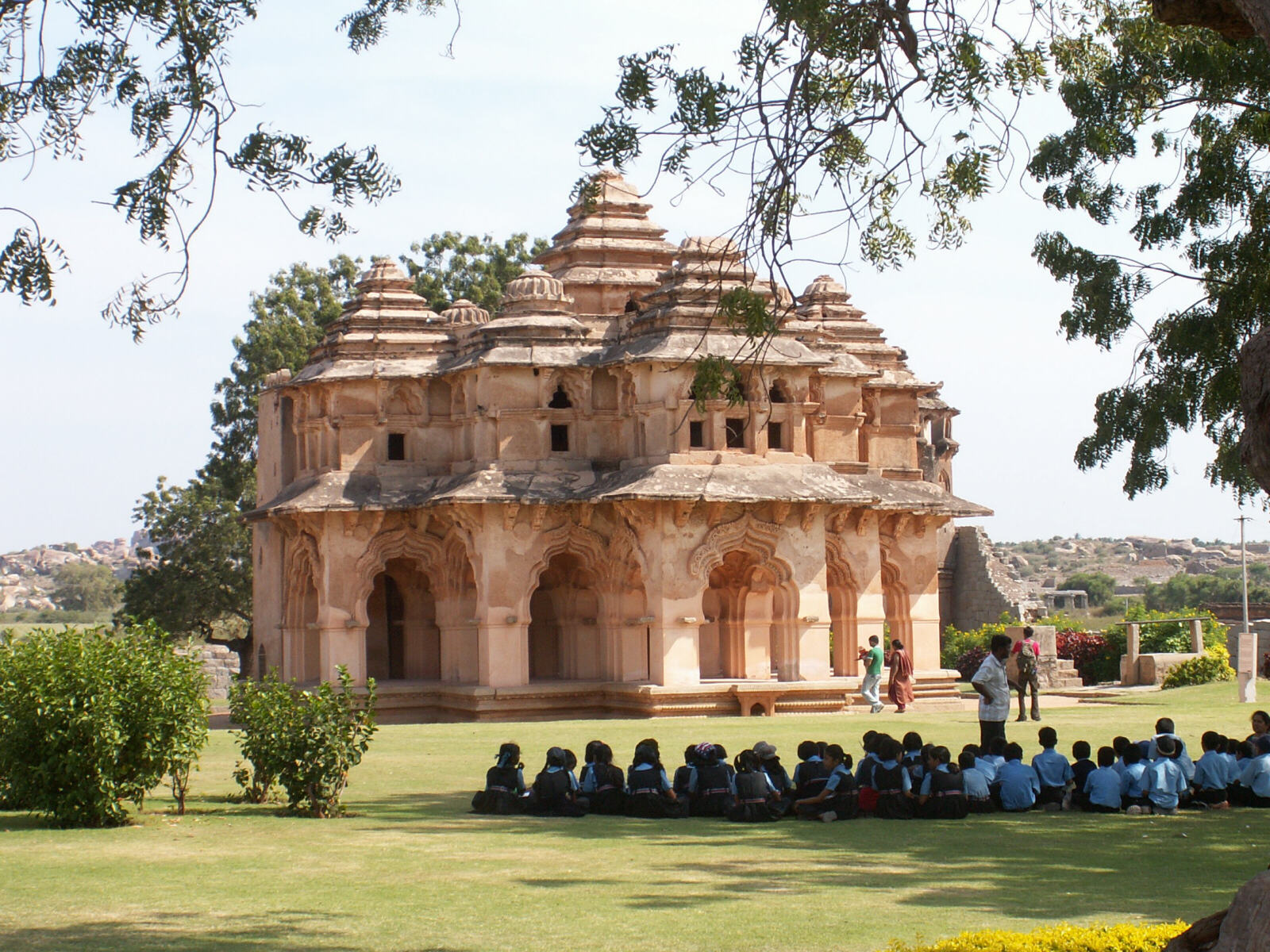
|
The children were not quite so well-behaved when they're having their photo taken! |
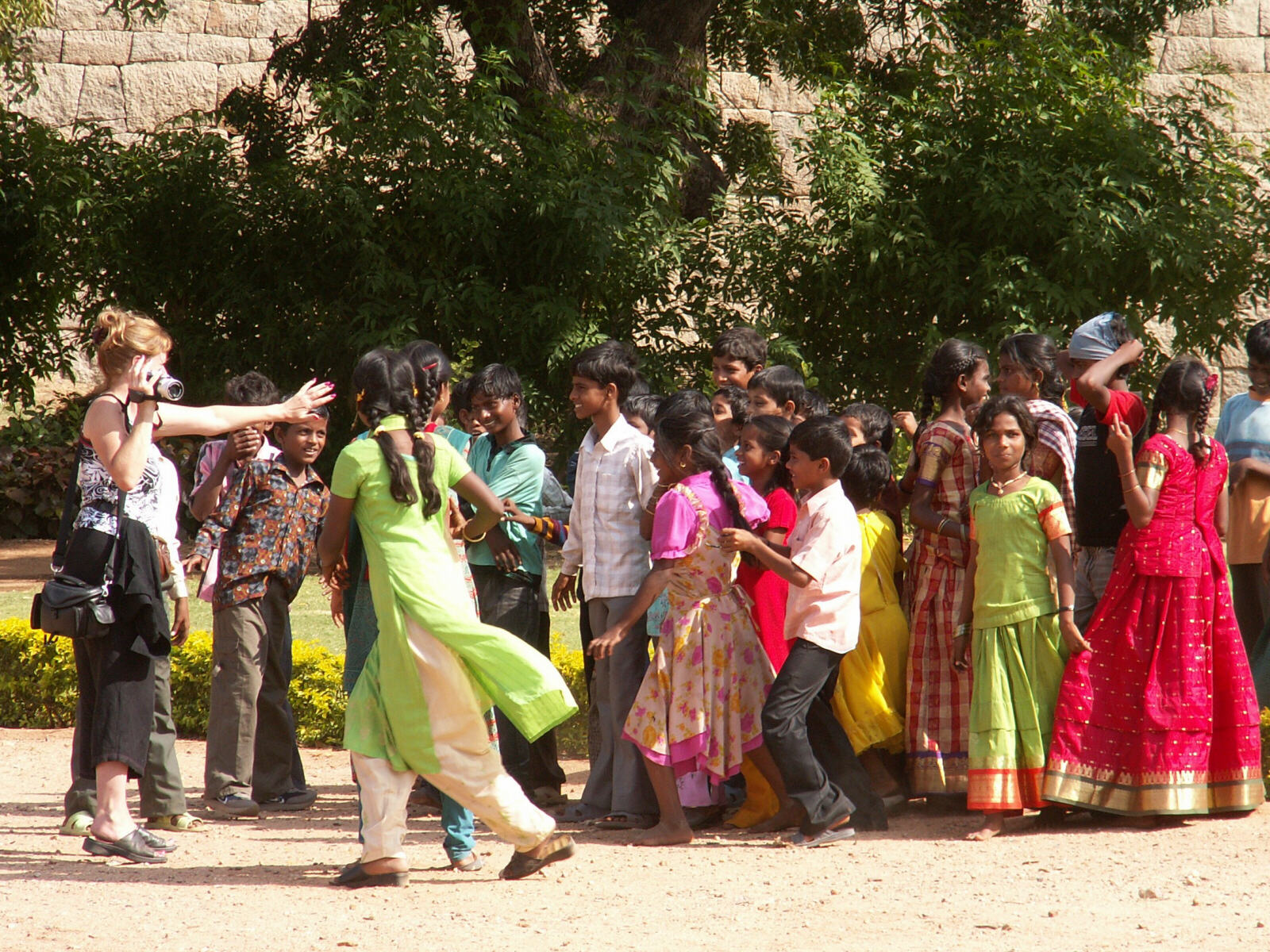
|
Then the Hazara Rama temple, the Royal Enclosure and the Queen's bath, all in the 'royal centre', then way across the valley to the elaborately decorated Vittala temple which is a world heritage site. The chariot in the temple complex has wheels that can actually turn.
|
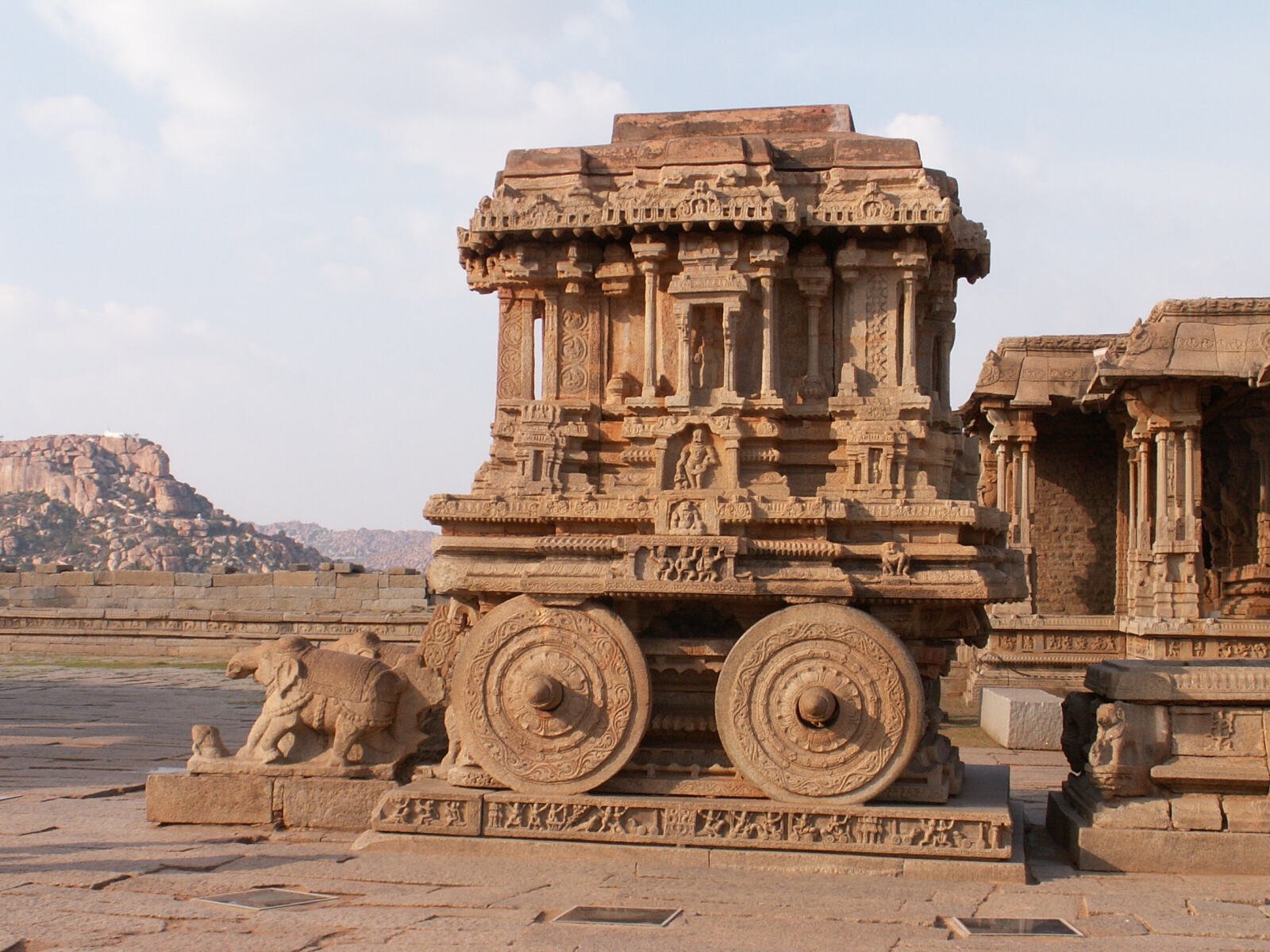
|
Finally we went down to the river to see the ruins of the ancient bridge. It seemed to be a big day for school outings and at each place hordes of smiling children descended on us shouting "what is your name" and trying to get on our photographs, then we'd see some of the same ones at the next place and they'd shout out our names to the ones who'd forgotten them. It was a great tour and we liked Hampi so much we decided to 'chill out' and stay a day longer than we planned. In the evening we had to go back to Hospet to find an ATM and also to check out the sleeper buses to Goa until Sheila found one she liked which we booked for the day after tomorrow, then we went back to New Eagle Garden restaurant for another nice meal.
Thurs 30th. Up and out for another day's sightseeing in the impressive ruins of Hampi. We got the little ferryboat across the river then went to the 'Monkey temple' perched on the top of a big rocky hill up 500 steps, with great views of the river and valley below. Then to the Lakshmi temple with its lotus pool and the Durga temple which had an old watchtower and gateway up the hill behind it. Then we went into Anegondi town where there was a large wooden chariot used in religious festivals in the central square, with the queen's pretty palace behind it. |
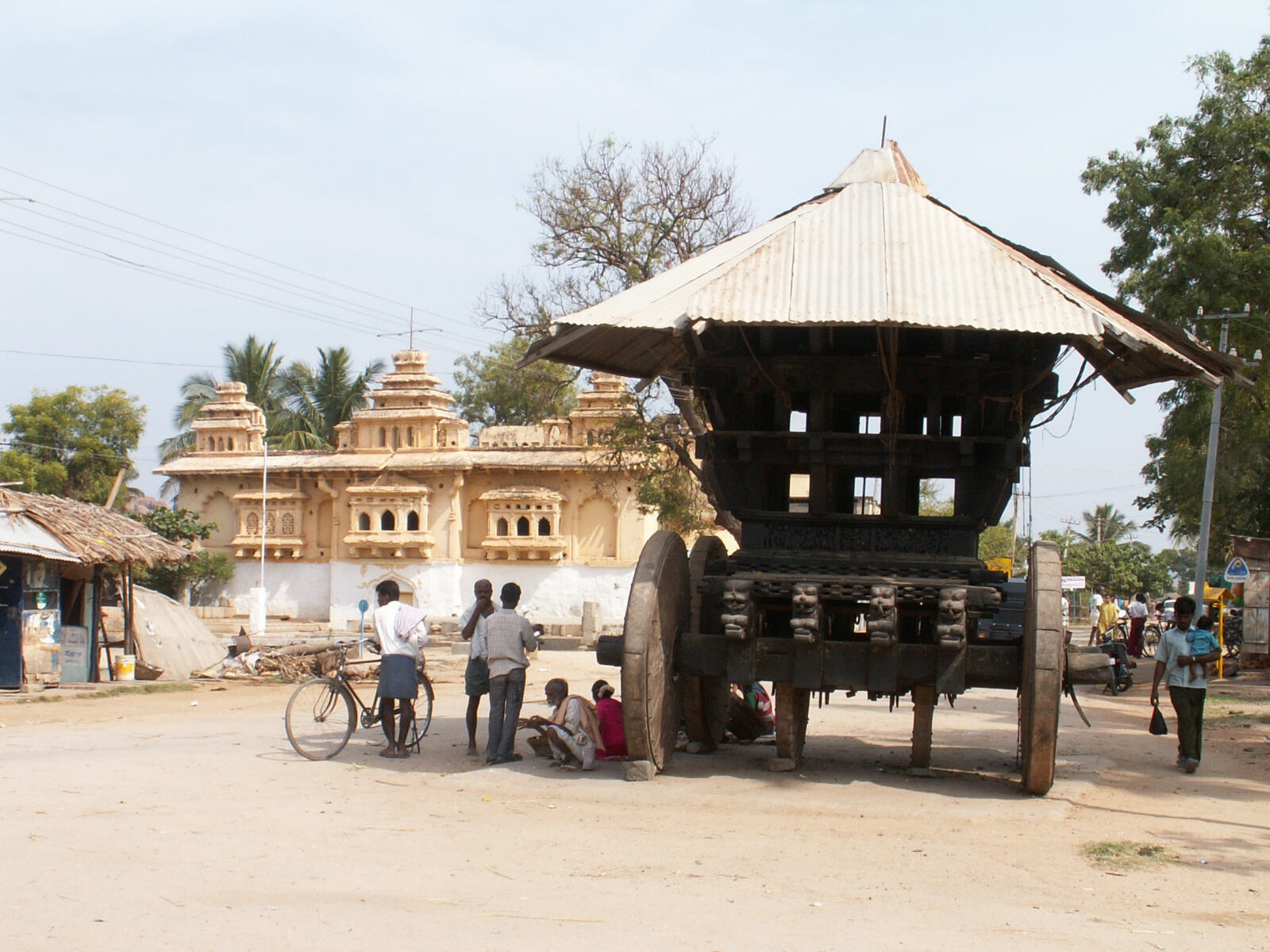
|
Unloading the hay from a bullock cart in Anegondi. |
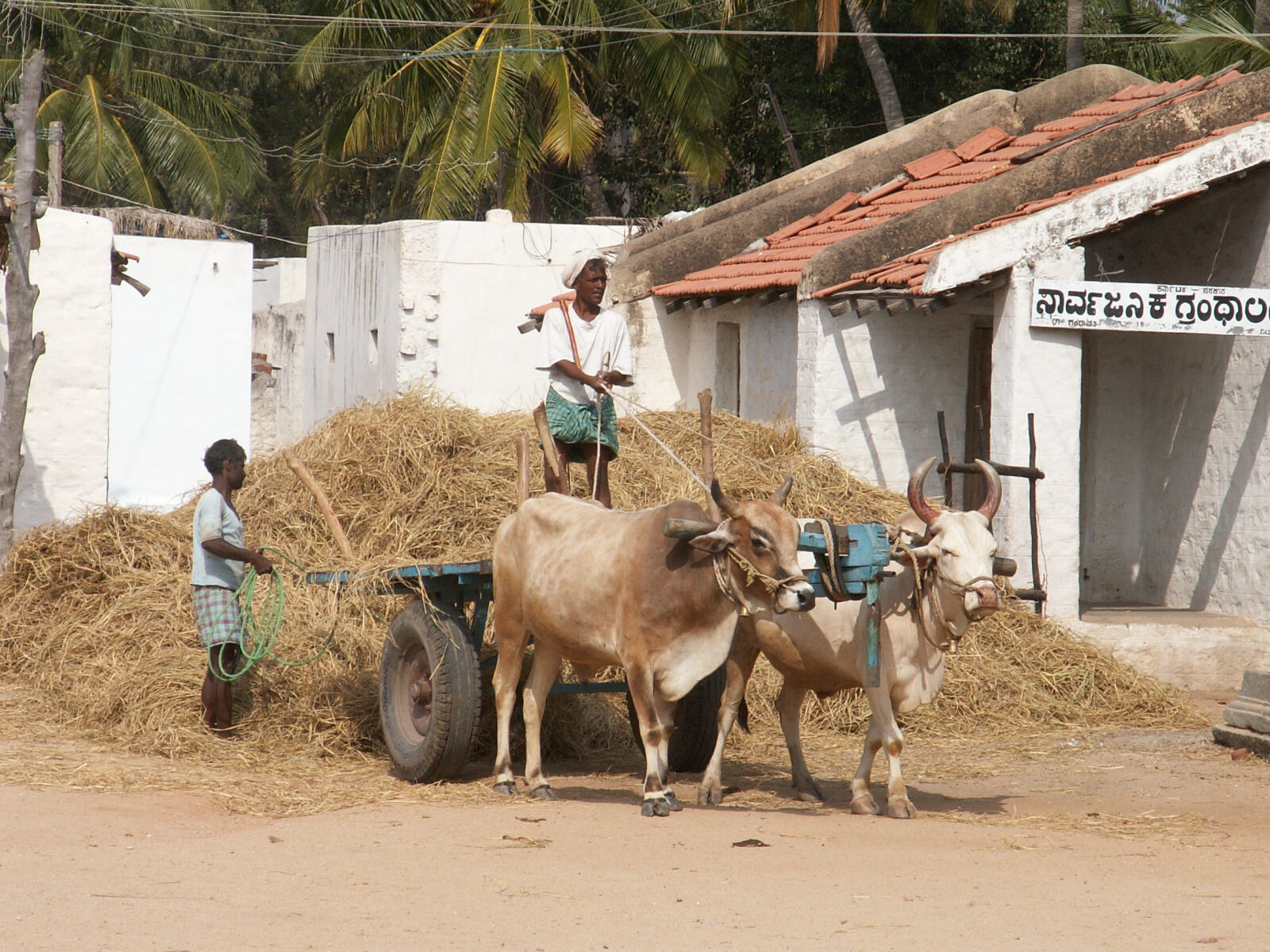
|
We went down to the massive river gate, where men were making coracles out of bamboo, sacking and tar, and the finished coracles were providing a ferry service across the river in the shadow of the not-quite-completed new bridge. After each crossing the ferryman had to spend some time bailing it out. |
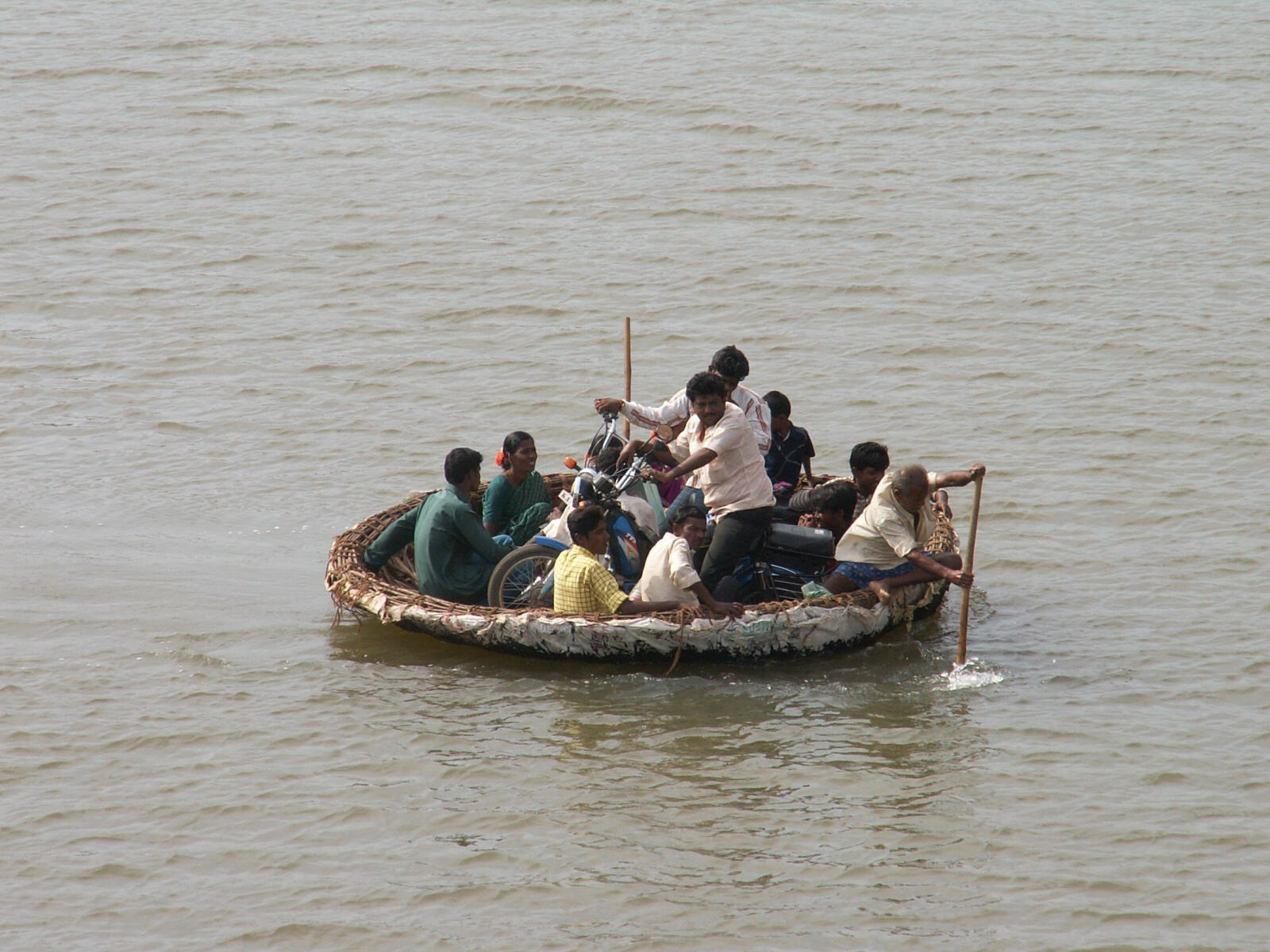
|
We had lunch at the rooftop Green Café, reclining on cushions on the floor beside low tables Indian-style, which seems to be how most of the cafés in Hampi are set out, then caught the ferry back to the main town where we had a relaxed afternoon in the shops and internet café. In the evening we took our two small bottles of champagne, courtesy of British Airways on the flight out and chilled in the fridge by our guesthouse proprietors, to an Italian-style restaurant and had a celebration because Hampi has been such a pleasant surprise. In fact we had to celebrate surreptitiously because the restaurant owner told us alcohol is actually illegal in Hampi because it is a religious centre, so we sat in a secluded area at the back and the champagne went very nicely with the authentic pizza and lasagne.
Fri 1st December. We went and had a leisurely breakfast overlooking the temple at one of the rooftop restaurants on the little street which leads down to the river, then Sheila set about some serious haggling in the shops. Luckily this did not result in any expenditure, and then we set out on a walking tour of the area - we went down the road to the Nandi monolith then up the steps over the hill to Achyutaraya temple which was very impressive but more ruinous than some of the others. We went down the ceremonial walkway in front of the temple then walked along the path above the river to the ancient bridge near Vittala temple, and the nearby ghats which seemed to be a popular picnic spot for people sitting by the river. We walked back along the riverside path, stopping for a welcome cold lemon soda at a café with a great view of the river running through the rocky canyon and the occasional coracle paddling past. |
Anjuna Beach, Goa
|
After a meal (lunch/tea/dinner) at the Italian-style restaurant we set off for Hospet and caught the overnight sleeper bus to Goa. This particular sleeper bus was great, we had a two-berth upper compartment with a sliding door so we were completely self-contained, lying in bed watching the world go past our window. It was a bumpy ride and we were flung from side to side occasionally, but we actually slept very well and arrived in Panaji town at daybreak.
Sat 2nd and Sun 3rd. In Panaji we hit a problem because all the hotels were full because a film festival and a religious festival were in progress, so we booked a hotel there for a couple of days' time and headed for the beach. We went to Anjuna which is developed enough to have lots of cafés, restaurants and guest houses but not yet overtaken by mass package tourist development. We stayed at the Palmasol Beach Resort which is a nice little guest house but not actually on the beach, then spent the days wandering along the beach stopping to sunbathe and have cold drinks and snacks in various of the beachfront cafés. There is a famous flea market there but alas our suitcases are full! After watching nice sunsets over the sea through the palm trees we went and had fantastic tandoori chickens at Hanuman's café by the little village square. We are really enjoying chilling out on the beach in Goa, but I've almost finished the book I'm reading and then what will I do ……? |
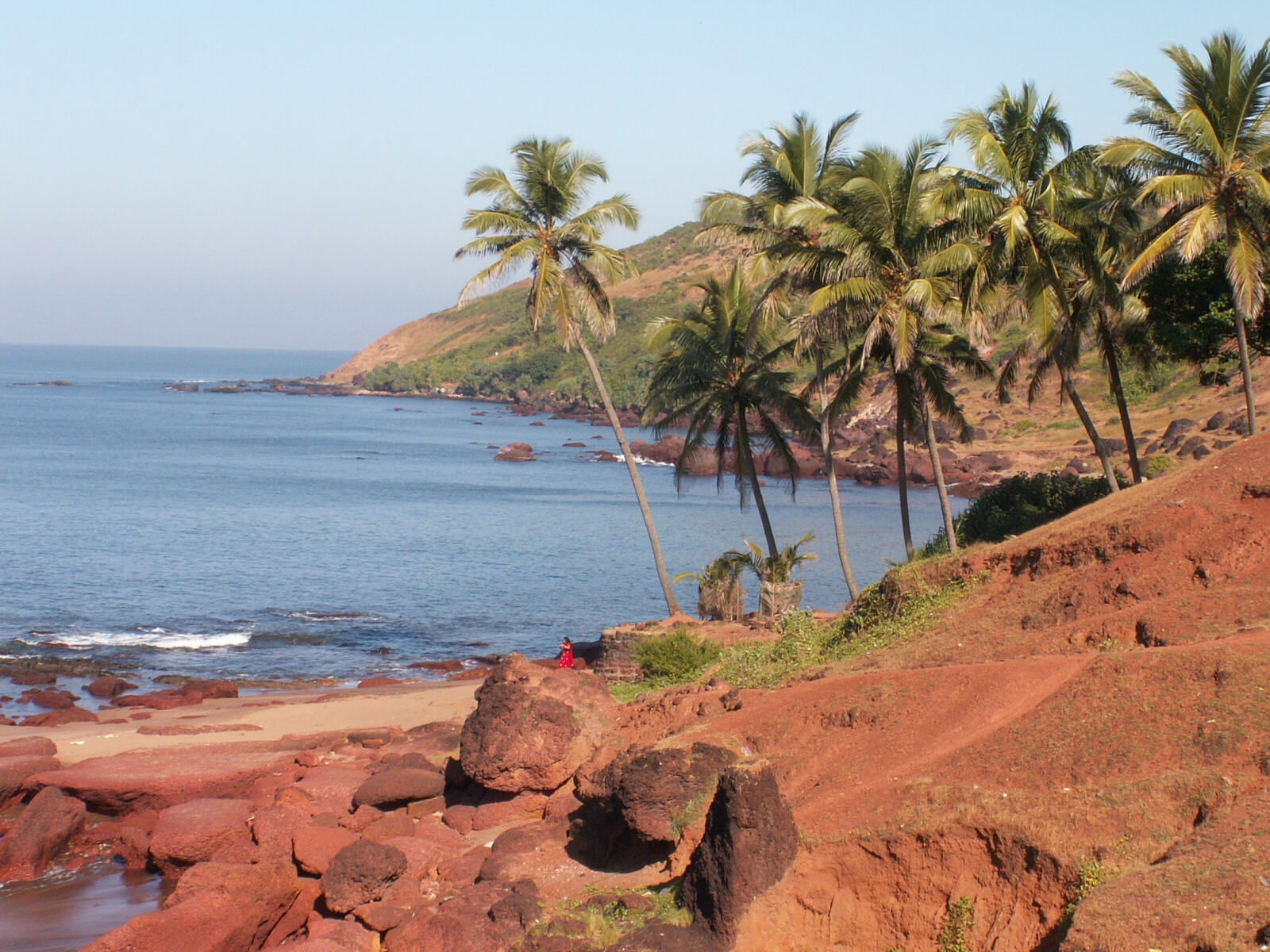
|
Panaji, Goa
|
Mon 4th. First thing in the morning we got a taxi to Panaji, the capital of Goa, and checked into the Panjim Inn, a delightful 300-year old mansion with charming rooms with four-poster beds. This is at the luxury end of our budget at nearly 20 pounds a night, but it was worth it. |

|
After a quick breakfast at the nearby Viva Panjim restaurant we went and reconfirmed our flight tickets at the British Airways office (after being surprised to find that there was one), found out the time of our train to Bombay at the railway booking office (there is no station, the railway office is at the bus station), and got on a bus to Old Goa. We made a mistake and got on the first bus which meant that we had to stand all the way (only 11 standing passengers allowed, but they managed to cram 20 on so it was pretty uncomfortable). However, when we got to Old Goa which is the former Portuguese capital and has several historic churches, there was a festival in progress for the 500th anniversary of Saint Francis Xavier's birth, and the whole place was full of tourists and pilgrims in their 'Sunday best' saris and had a carnival atmosphere. We looked in the main churches, walked down through the archway to the river landing stage and queued up for an hour to walk past Saint Francis' tomb. It was all very interesting but unbelievably hot - this was the first day in India that the heat really got to us, so we got the bus back (waiting for the second one so we got some seats, so the ride was much more pleasant), and went to the characterful restaurant 'Hotel Venite' in another nice old Portuguese-style house, and cooled off on one of the tiny balconies over the street having ice cold beer and spicy Goan sausages. |
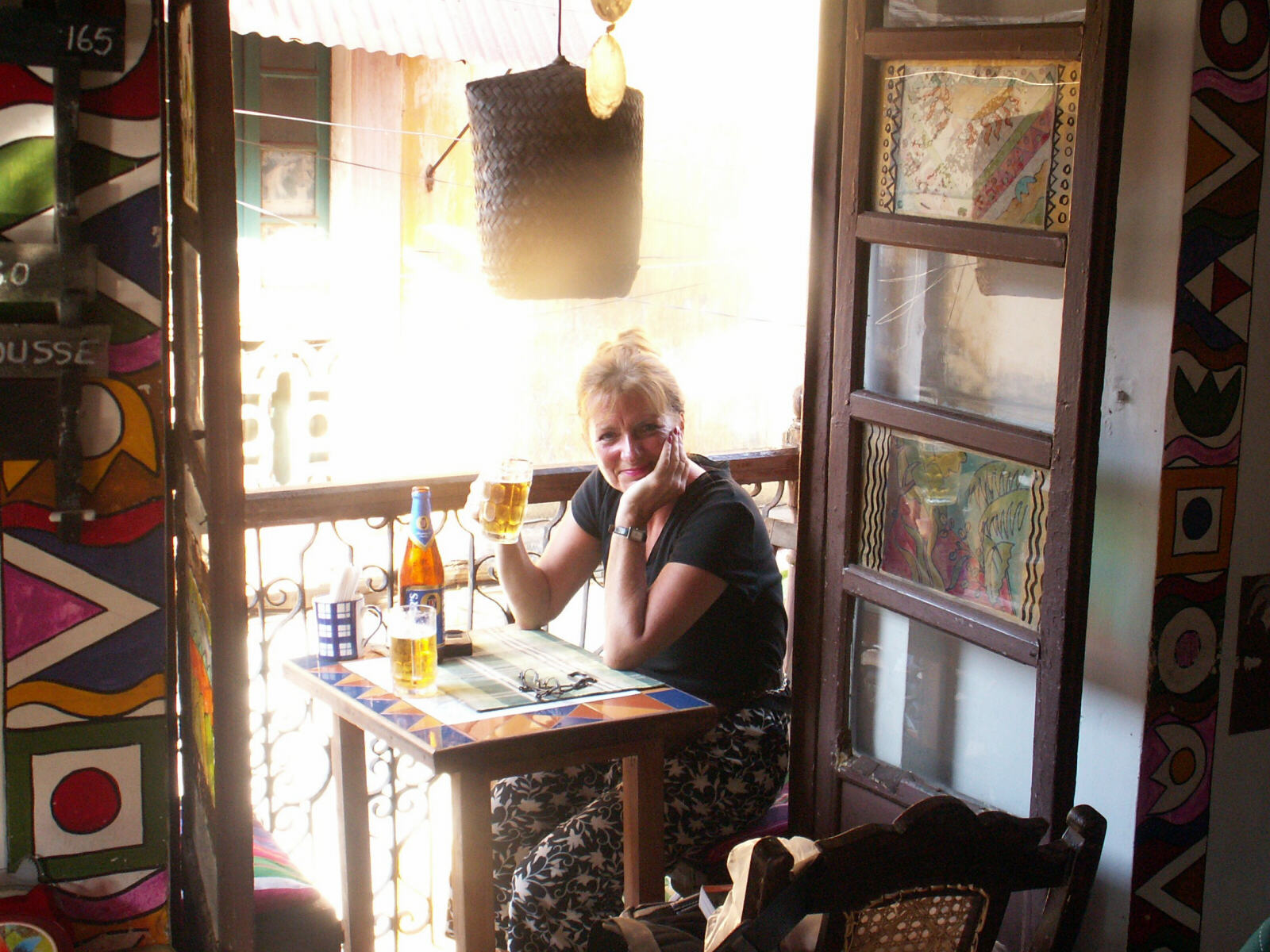
|
In the evening we walked across town and found a firework display and a brass band playing in front of the Church of Our Lady of the Immaculate Conception, apparently a continuation of the day's festival. We went on to the rather expensive Ser-E-Punjab restaurant where the food was tasty but the décor was very ordinary and there wasn't really any atmosphere.
Tue 5th. We had a very pleasant relaxed day in Panaji, starting with breakfast in the balcony restaurant at the Panjim Inn. |
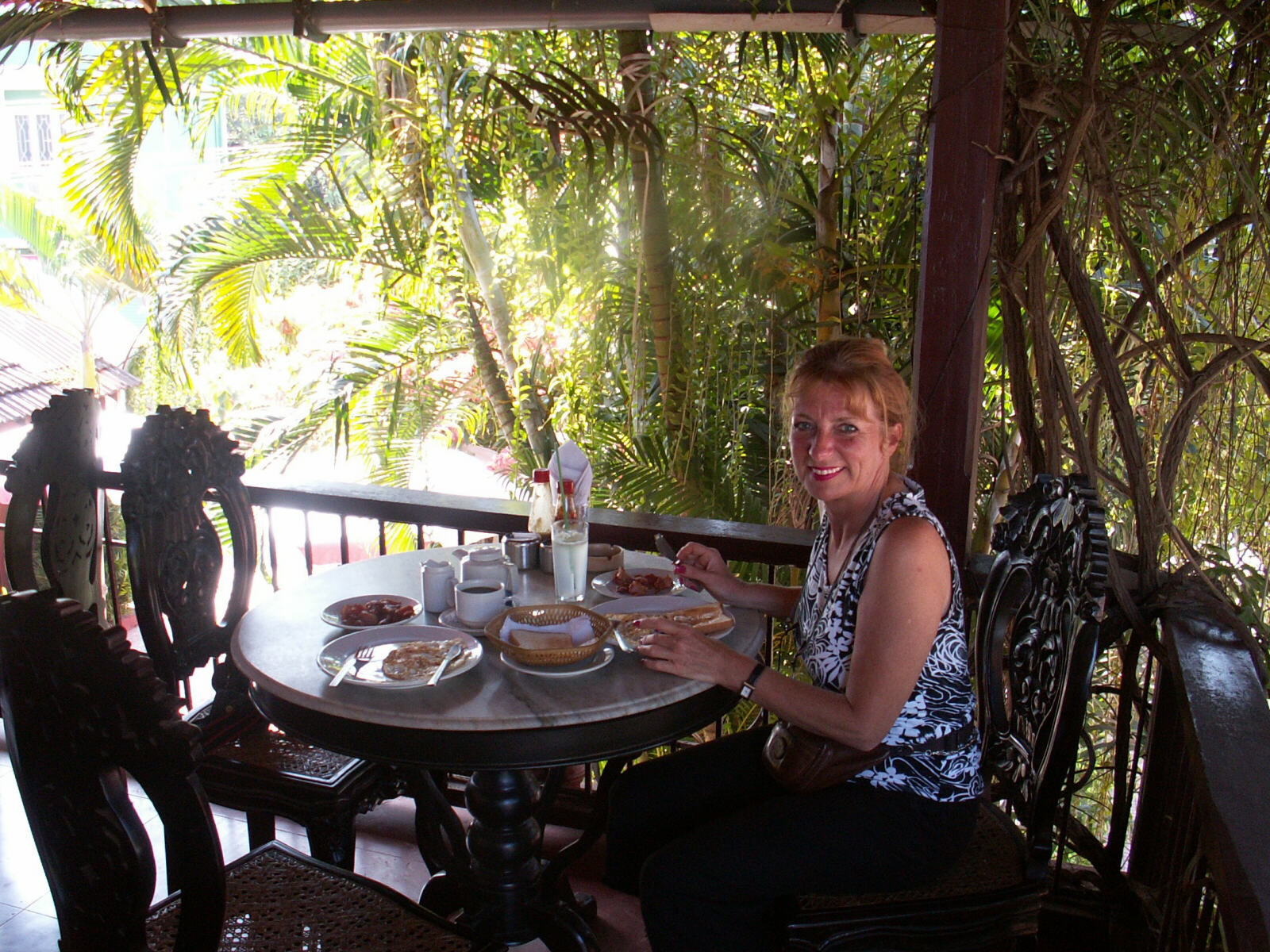
|
Sheila went for more beauty treatment to repair the ravages of lying in the sun (eyebrows threaded, legs waxed, Indian head massage, hair conditioned, facial, pedicure and haircut all for under eight pounds) while I went for a walking tour round Panaji, round the old Portuguese houses, up the stepped backstreets, to the fish market and back along the waterfront. There were fruit stalls in a street in the Fontainhas district. |
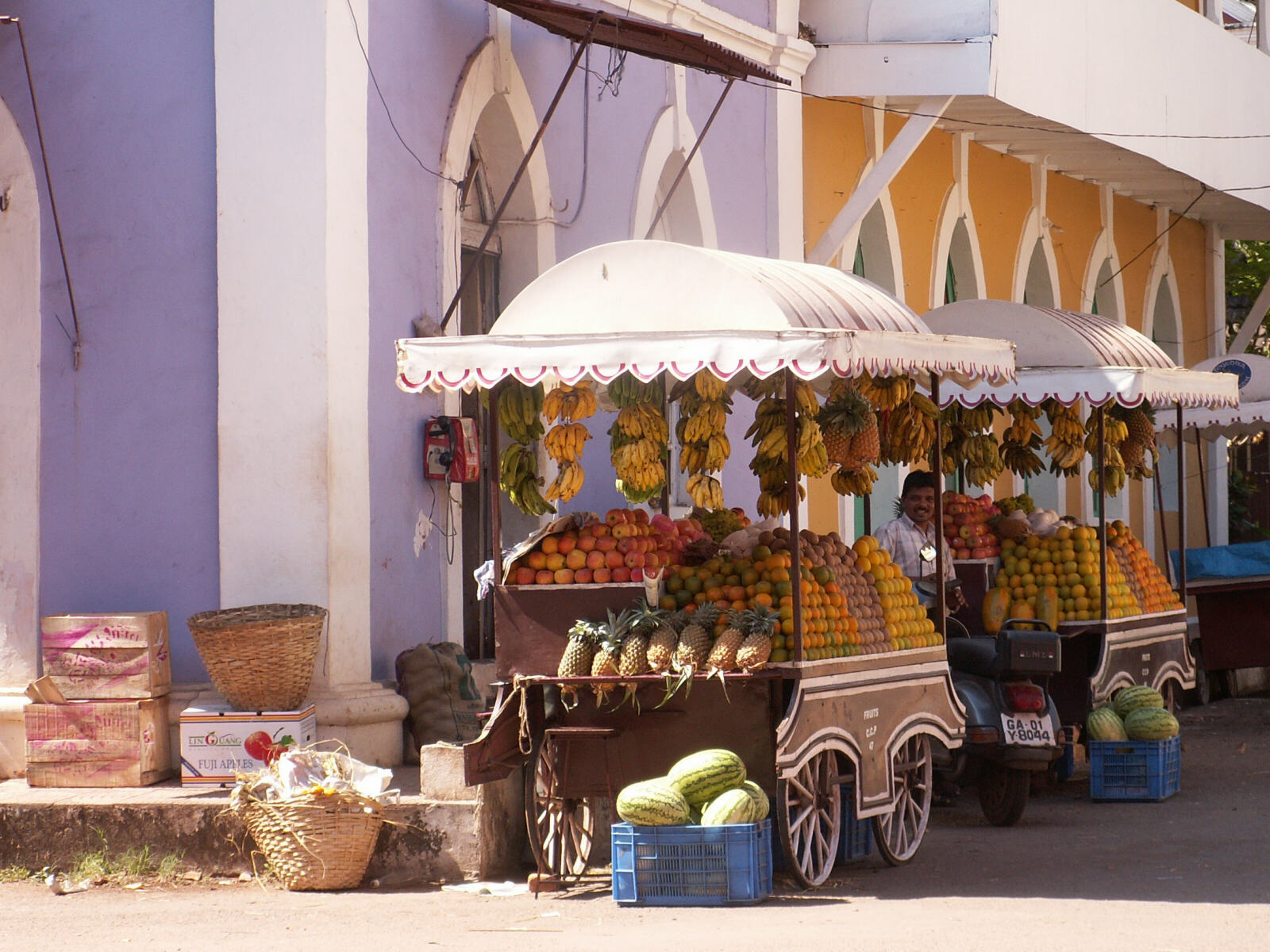
|
Not a murder in progress - it's a statue of the famous hypnotist Abbe Faria who was born in Panaji. |
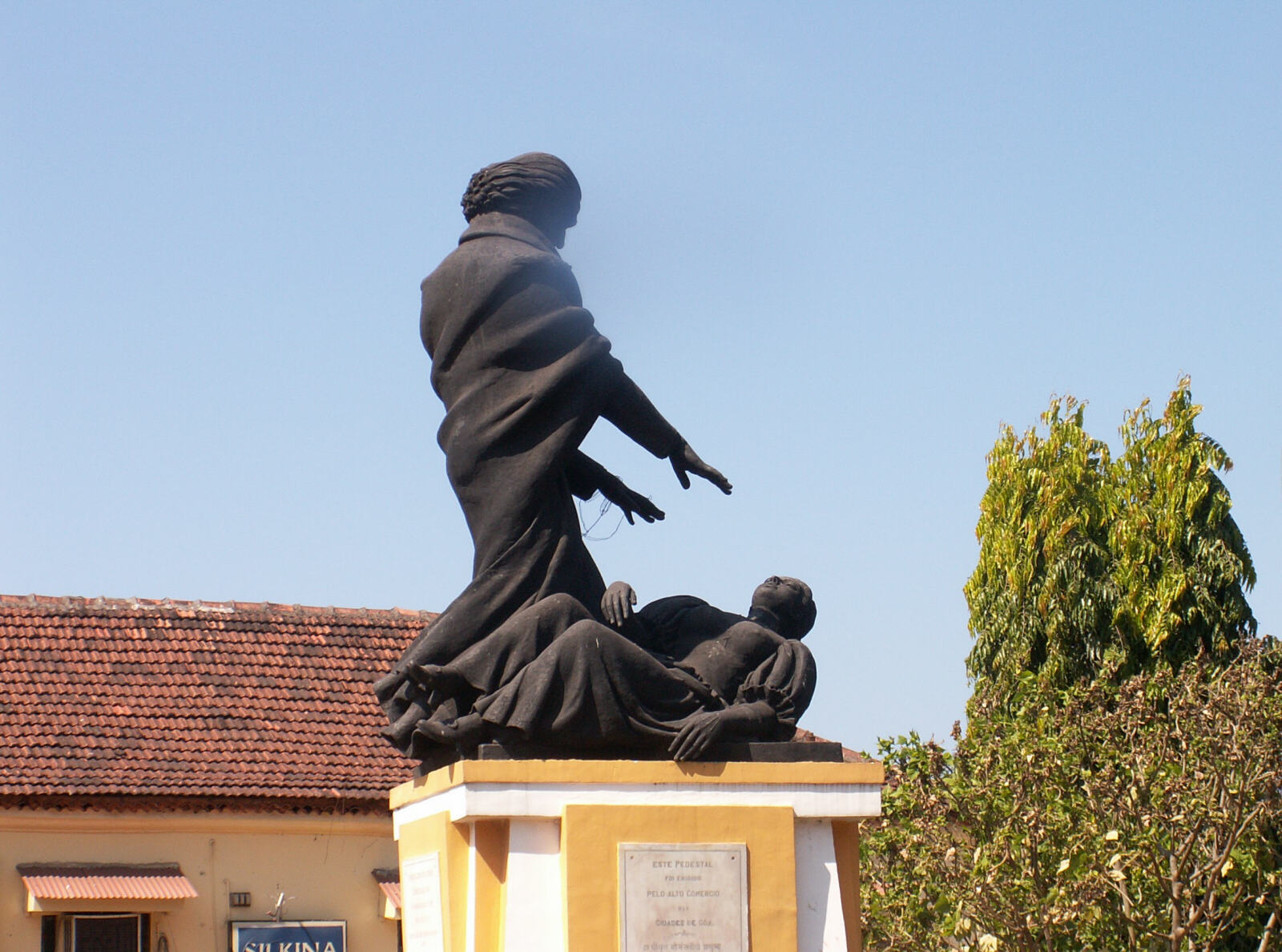
|
We then went to the Hotel Venite for 'lunch' which consisted of a couple of glasses of wine, then went for a little bit more of the walking tour to take the last few photos and whiled away the rest of the afternoon until it was time to go back to Hotel Venite and sit on another balcony over the street having prawn curry and spicy Goan sausages. It was all very pleasant and apart from the frequent power cuts we could easily be in southern Europe.
Weds 6th. We had another relaxed breakfast at the Panjim Inn and a bit more walking around the town before loading our cases into Jerry's autorickshaw and driving down to Chandor in south Goa. Here, in a sleepy little village, is the Braganza House, the wonderful 400-year old mansion of the family who were the major landowners for miles around until their land was confiscated by the Indian government when it took over Goa in 1961. The family still own the mansion and it is still full of priceless antiques although they say the most valuable stuff was stolen when they were forced to leave the country for a few years.
From there we went to the railway station at Margao where we caught the 6pm Konkan Express for Bombay. This time we were going first class AC, with comfortable cloth seats/bunks, copious bedding, a wardrobe and a washbasin, all in a self-contained two-berth cabin of our own. Even the train was smoother and quieter than the others we have been on - a bit of luxury to finish with.
|
Bombay (Mumbai)
|
Thurs 7th. The train left last night exactly on time at 6pm and arrived at Victoria Terminus in Bombay exactly on time at 6am, a remarkable piece of timekeeping. Victoria Terminus, Bombay - this is what a railway station ought to look like. |
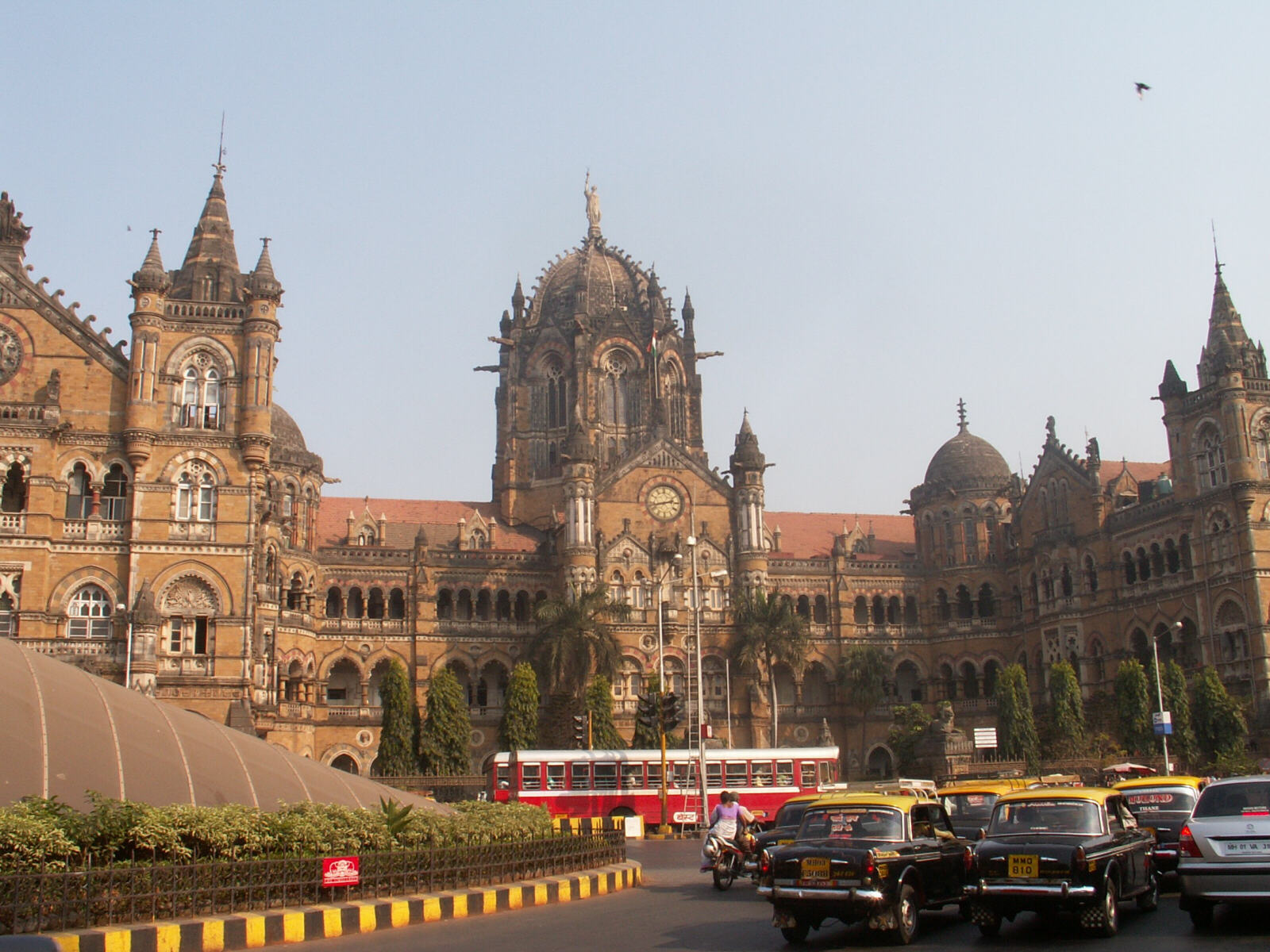
|
Of course, as soon as we got a taxi to take us to the hotel we'd booked, he started trying to sell us 'his' hotels instead. We decided to take a look and in fact one of his, the Antique Hotel, was just as nice as ours and ten pounds cheaper, so we stayed there. We then set out for a walk, through Colaba Market to Strand Road with its views of the harbour and down to the Gateway of India, emblem of the city and a bustling boat dock with people and boats coming and going all the time. This would be your first view of India if you arrive from Europe by sea. |
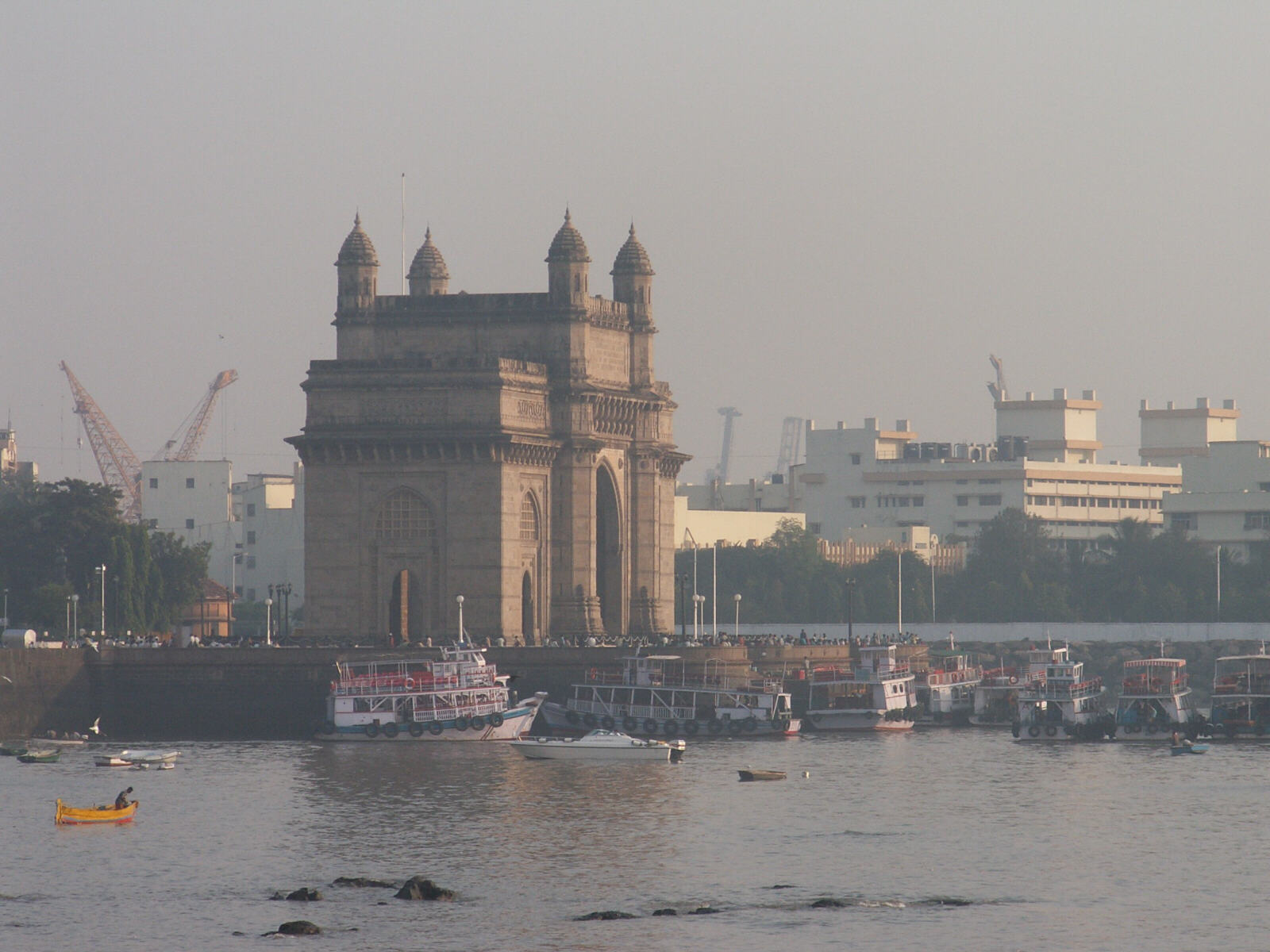
|
We walked up to Wellington Circle looking at shops, then got a taxi to Mohammed Ali Street where there were supposed to be lots of joss-stick shops but we had all sorts of trouble finding them, until we stumbled on Samuel Street where two different very nice shopkeepers gave us a cup of tea, told us all about the different types of joss-stick they had, and one showed us the 'factory' at the back of his shop where two women were making the joss-sticks. From there we walked through Crawford market and all the way back through the commercial district of Bombay, through 'the grand 19th century edifices of British commercial firms with their elegant arcades clogged by hawkers' stalls' as the book so accurately puts it, and back to the Gateway. Nearby was the very grand Taj Mahal hotel, one of the famous historic hotels of the orient. |
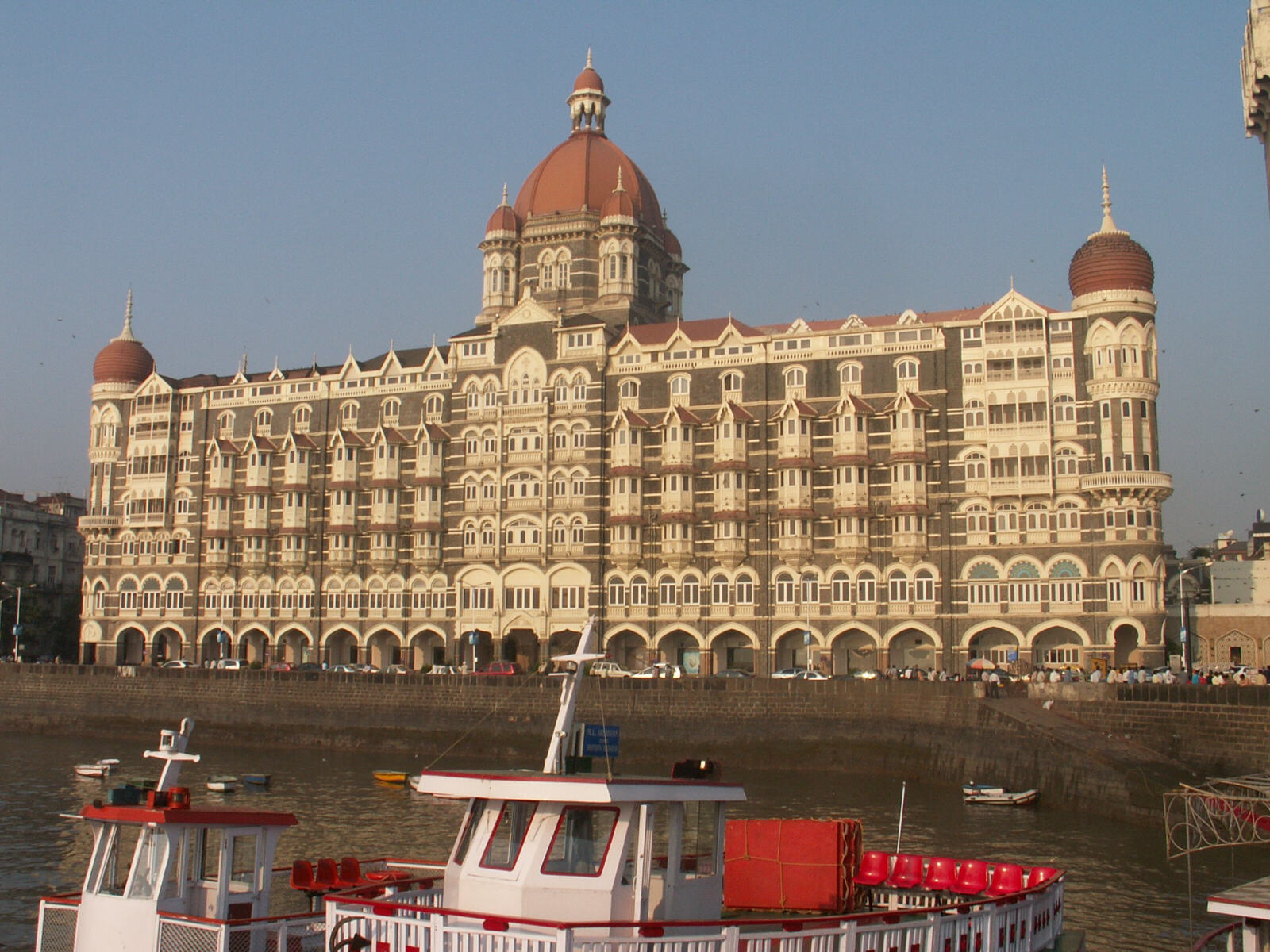
|
We had booked afternoon tea at the Taj by e-mail. They somehow spotted us before we said anything and greeted us by name, and gave us a table by the window with a great view of the harbour. 'High Tea' was a wonderful buffet with everything from finger sandwiches, smoked salmon and scones with jam and cream through an assortment of Indian and Chinese savouries like samosas and dim sum to really rich chocolate cakes. We spent two hours stuffing ourselves while they brought endless pots of tea and it was wonderful. |
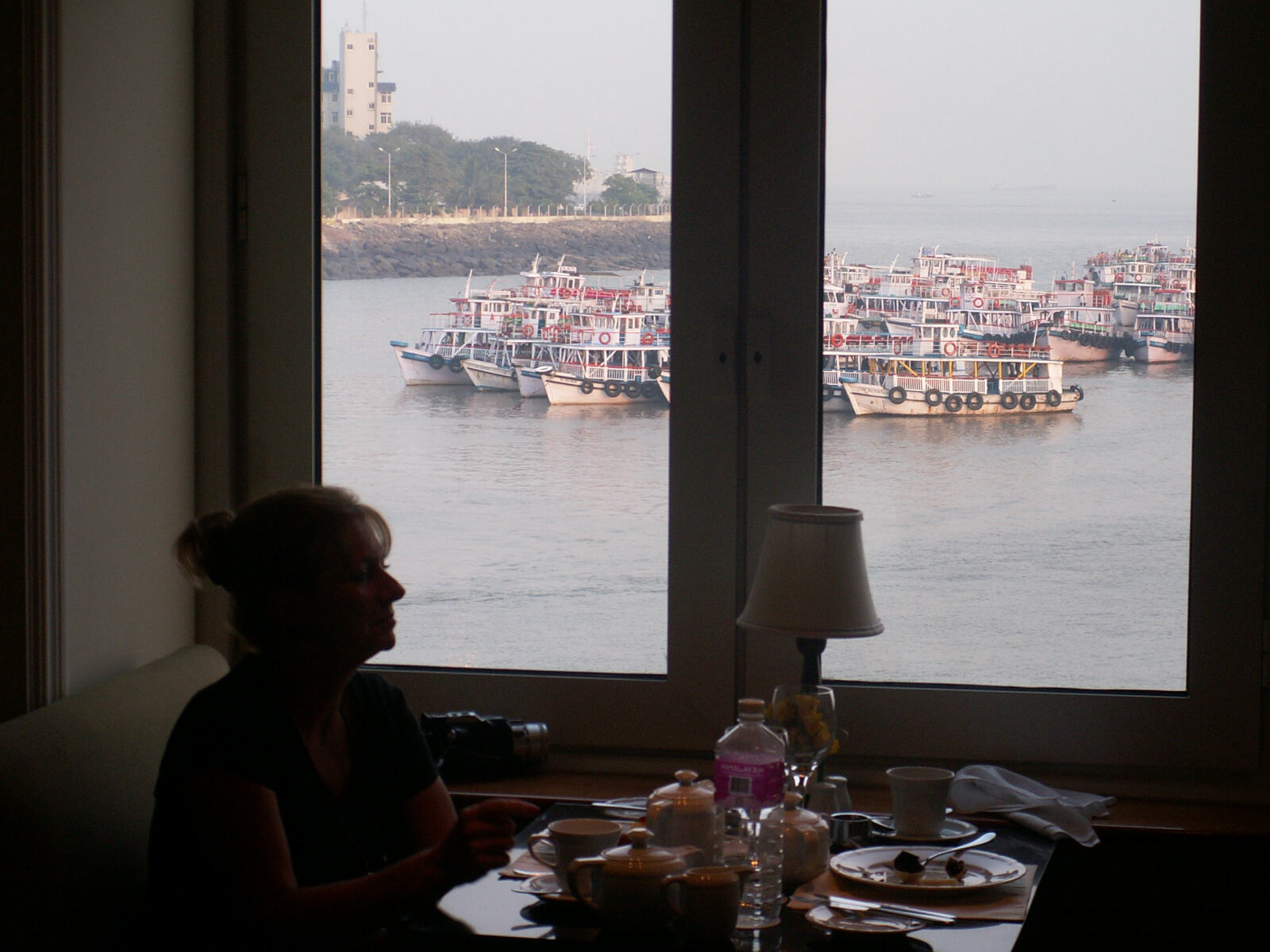
|
We didn't feel like eating anything that evening after the huge high tea so we walked down Colaba Causeway, the main road in this part of town, until we found a bar in a Chinese restaurant, and sat with a beer in the window watching the world go by in the street outside.
Fri 8th. We had an exotic breakfast of baked beans on toast with coriander, chilli sauce and onions at the café Mondegar, then went to the airport and flew home. The flight was half empty so Sheila had the luxury of reclining across four central seats drinking sparkling wine and orange juice and watching films, while I sat by a window watching the snow-covered mountains of Iran and Turkey drift slowly by. It was a nice finalé. |
If you would like to see more of our travels just click the map.

|